Strategic Management Review
VerifiedAdded on 2020/10/23
|22
|6927
|74
AI Summary
This assignment involves reviewing and analyzing various strategic management concepts, including Porter's Five Forces, Value Chain Analysis, and resource-based views. It also covers dynamic managerial capabilities, alliance brands, and managing strategic airline alliances. The document includes a list of references to relevant studies and research papers in the field of strategic management.
Contribute Materials
Your contribution can guide someone’s learning journey. Share your
documents today.
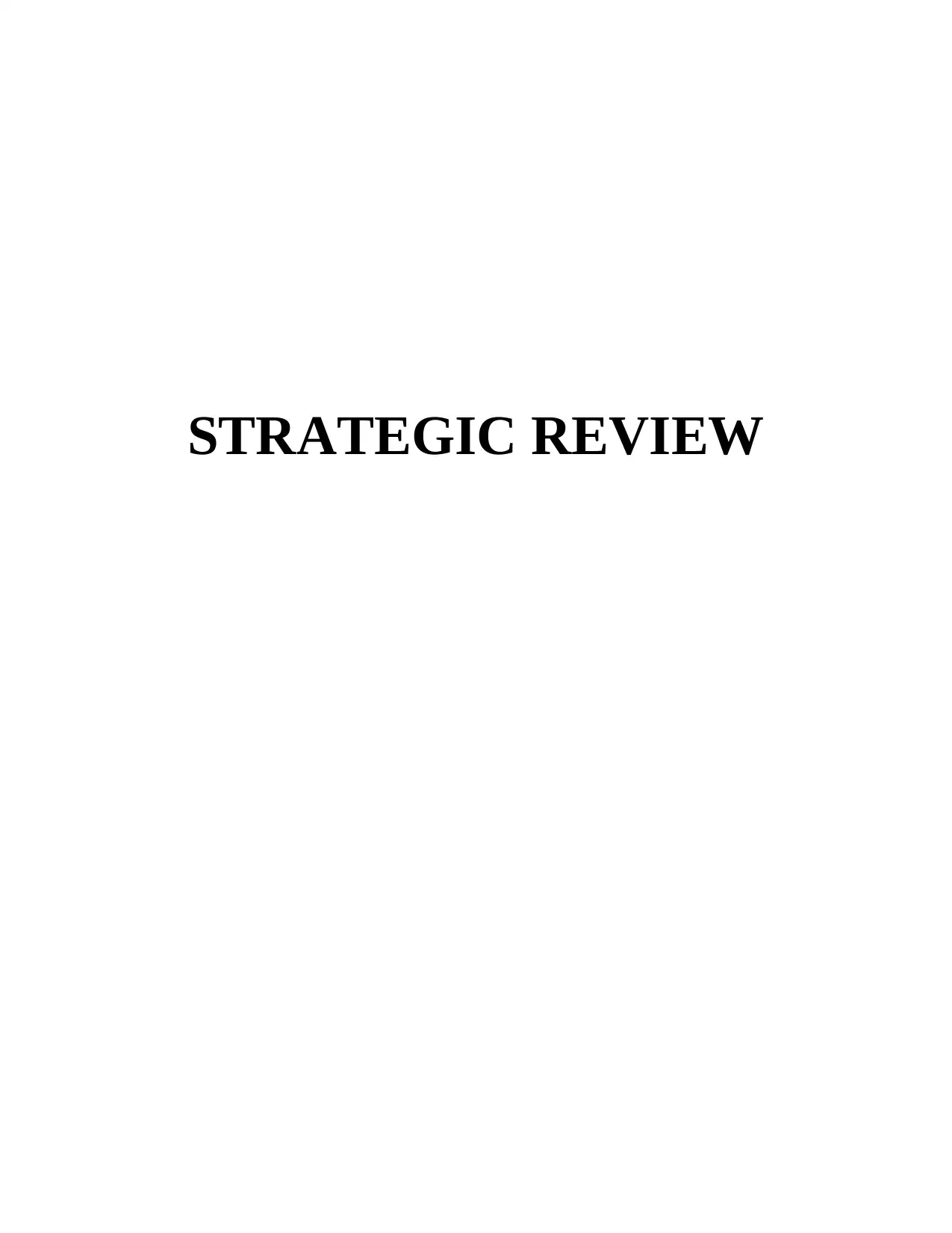
STRATEGIC REVIEW
Secure Best Marks with AI Grader
Need help grading? Try our AI Grader for instant feedback on your assignments.
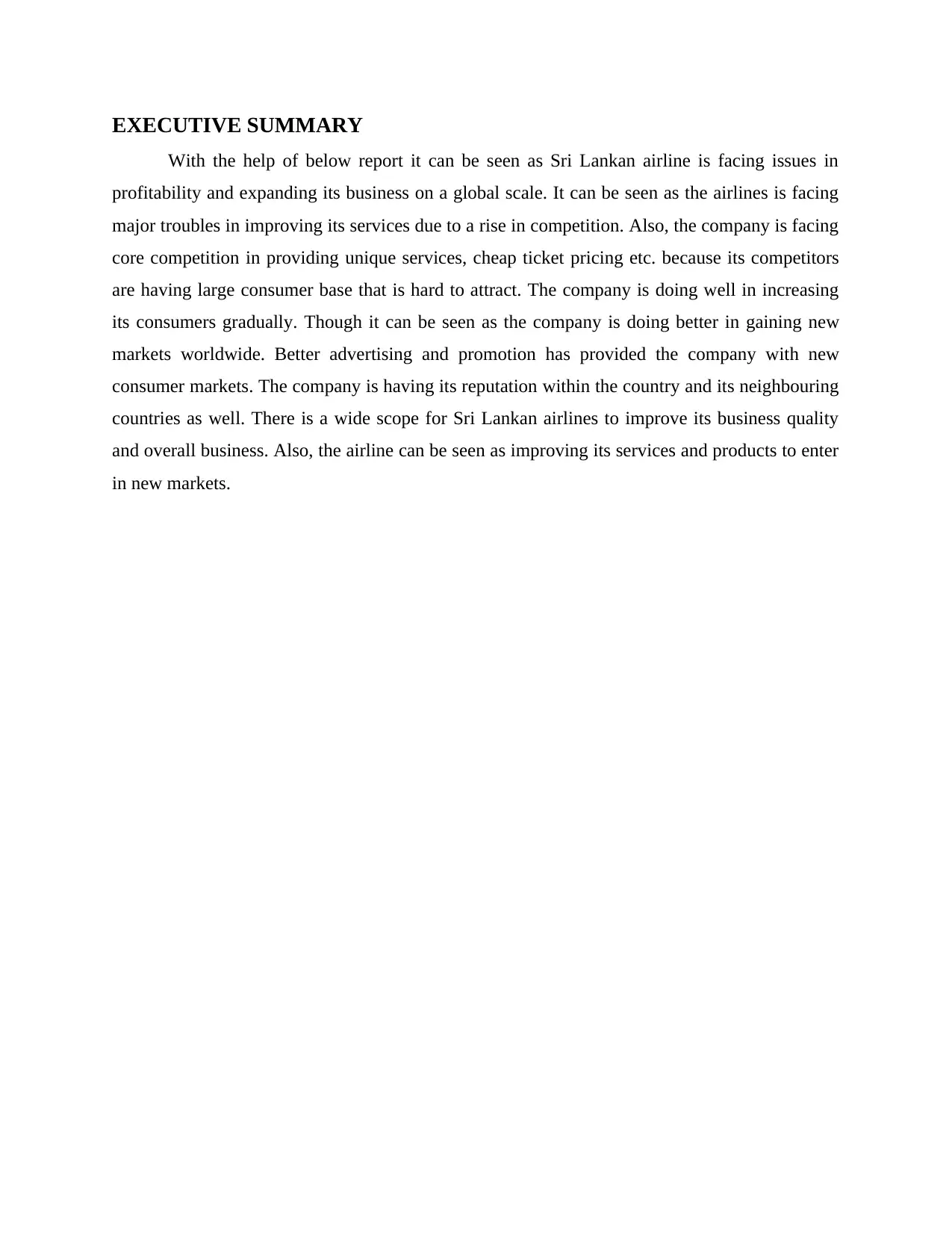
EXECUTIVE SUMMARY
With the help of below report it can be seen as Sri Lankan airline is facing issues in
profitability and expanding its business on a global scale. It can be seen as the airlines is facing
major troubles in improving its services due to a rise in competition. Also, the company is facing
core competition in providing unique services, cheap ticket pricing etc. because its competitors
are having large consumer base that is hard to attract. The company is doing well in increasing
its consumers gradually. Though it can be seen as the company is doing better in gaining new
markets worldwide. Better advertising and promotion has provided the company with new
consumer markets. The company is having its reputation within the country and its neighbouring
countries as well. There is a wide scope for Sri Lankan airlines to improve its business quality
and overall business. Also, the airline can be seen as improving its services and products to enter
in new markets.
With the help of below report it can be seen as Sri Lankan airline is facing issues in
profitability and expanding its business on a global scale. It can be seen as the airlines is facing
major troubles in improving its services due to a rise in competition. Also, the company is facing
core competition in providing unique services, cheap ticket pricing etc. because its competitors
are having large consumer base that is hard to attract. The company is doing well in increasing
its consumers gradually. Though it can be seen as the company is doing better in gaining new
markets worldwide. Better advertising and promotion has provided the company with new
consumer markets. The company is having its reputation within the country and its neighbouring
countries as well. There is a wide scope for Sri Lankan airlines to improve its business quality
and overall business. Also, the airline can be seen as improving its services and products to enter
in new markets.
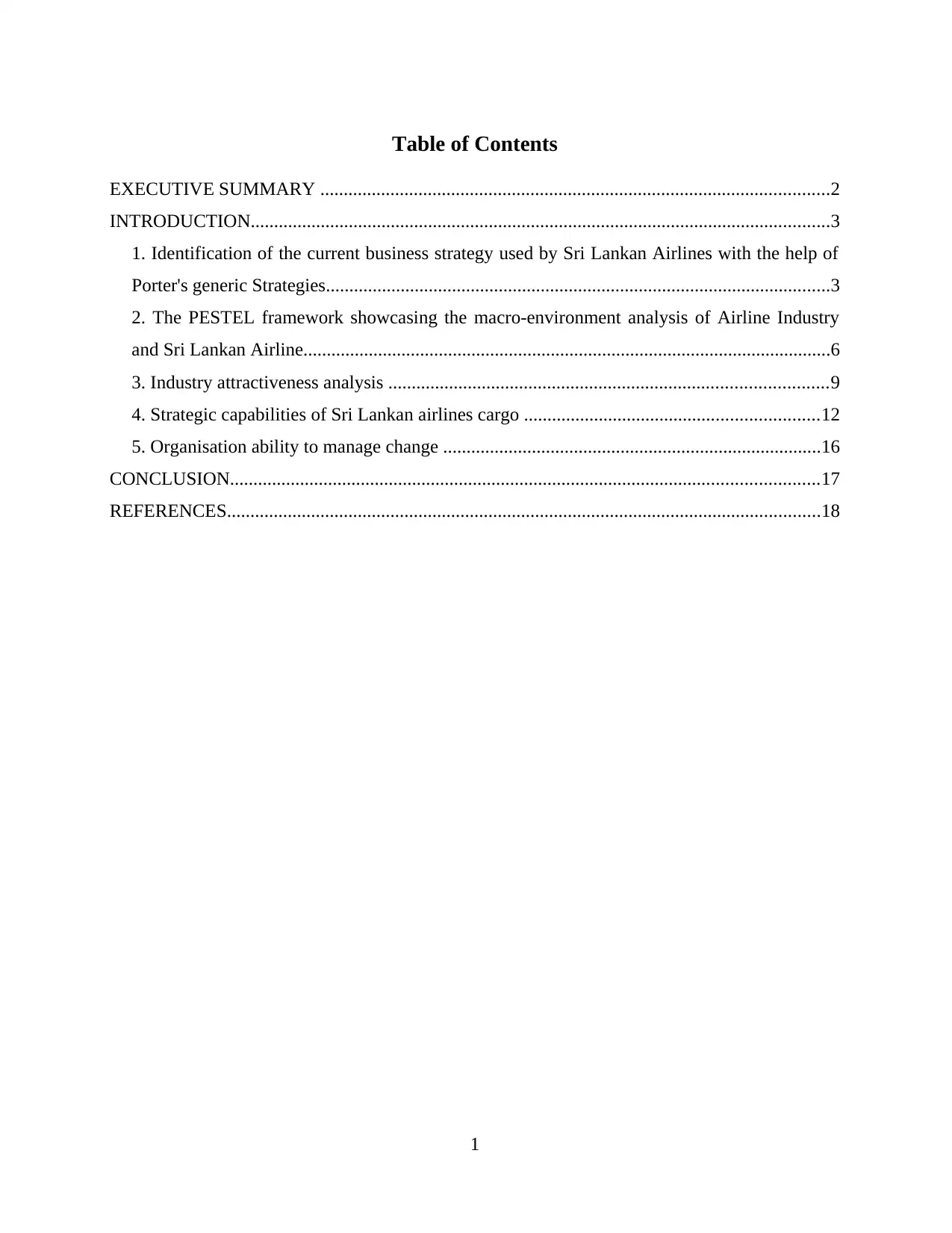
Table of Contents
EXECUTIVE SUMMARY .............................................................................................................2
INTRODUCTION............................................................................................................................3
1. Identification of the current business strategy used by Sri Lankan Airlines with the help of
Porter's generic Strategies............................................................................................................3
2. The PESTEL framework showcasing the macro-environment analysis of Airline Industry
and Sri Lankan Airline.................................................................................................................6
3. Industry attractiveness analysis ..............................................................................................9
4. Strategic capabilities of Sri Lankan airlines cargo ...............................................................12
5. Organisation ability to manage change .................................................................................16
CONCLUSION..............................................................................................................................17
REFERENCES...............................................................................................................................18
1
EXECUTIVE SUMMARY .............................................................................................................2
INTRODUCTION............................................................................................................................3
1. Identification of the current business strategy used by Sri Lankan Airlines with the help of
Porter's generic Strategies............................................................................................................3
2. The PESTEL framework showcasing the macro-environment analysis of Airline Industry
and Sri Lankan Airline.................................................................................................................6
3. Industry attractiveness analysis ..............................................................................................9
4. Strategic capabilities of Sri Lankan airlines cargo ...............................................................12
5. Organisation ability to manage change .................................................................................16
CONCLUSION..............................................................................................................................17
REFERENCES...............................................................................................................................18
1
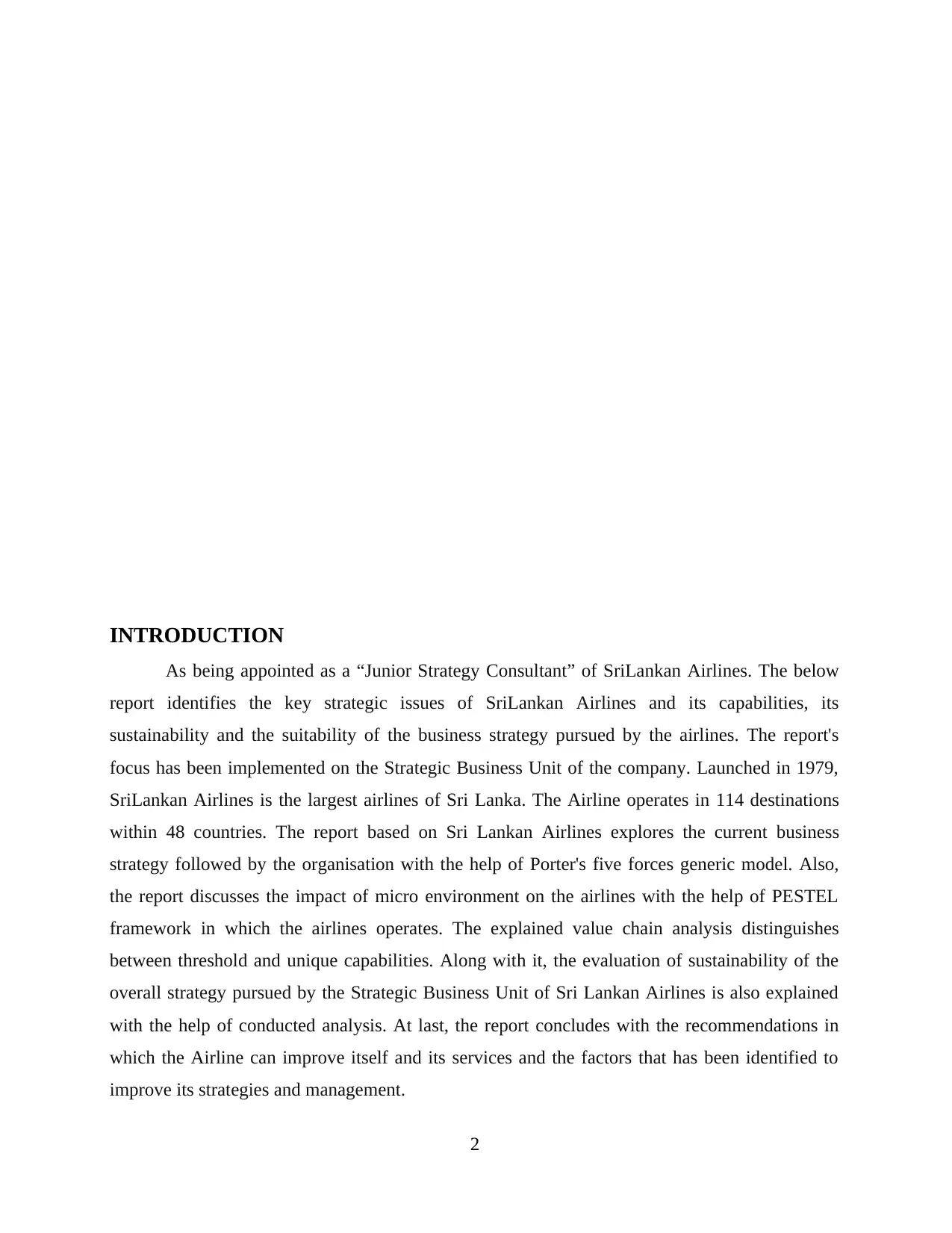
INTRODUCTION
As being appointed as a “Junior Strategy Consultant” of SriLankan Airlines. The below
report identifies the key strategic issues of SriLankan Airlines and its capabilities, its
sustainability and the suitability of the business strategy pursued by the airlines. The report's
focus has been implemented on the Strategic Business Unit of the company. Launched in 1979,
SriLankan Airlines is the largest airlines of Sri Lanka. The Airline operates in 114 destinations
within 48 countries. The report based on Sri Lankan Airlines explores the current business
strategy followed by the organisation with the help of Porter's five forces generic model. Also,
the report discusses the impact of micro environment on the airlines with the help of PESTEL
framework in which the airlines operates. The explained value chain analysis distinguishes
between threshold and unique capabilities. Along with it, the evaluation of sustainability of the
overall strategy pursued by the Strategic Business Unit of Sri Lankan Airlines is also explained
with the help of conducted analysis. At last, the report concludes with the recommendations in
which the Airline can improve itself and its services and the factors that has been identified to
improve its strategies and management.
2
As being appointed as a “Junior Strategy Consultant” of SriLankan Airlines. The below
report identifies the key strategic issues of SriLankan Airlines and its capabilities, its
sustainability and the suitability of the business strategy pursued by the airlines. The report's
focus has been implemented on the Strategic Business Unit of the company. Launched in 1979,
SriLankan Airlines is the largest airlines of Sri Lanka. The Airline operates in 114 destinations
within 48 countries. The report based on Sri Lankan Airlines explores the current business
strategy followed by the organisation with the help of Porter's five forces generic model. Also,
the report discusses the impact of micro environment on the airlines with the help of PESTEL
framework in which the airlines operates. The explained value chain analysis distinguishes
between threshold and unique capabilities. Along with it, the evaluation of sustainability of the
overall strategy pursued by the Strategic Business Unit of Sri Lankan Airlines is also explained
with the help of conducted analysis. At last, the report concludes with the recommendations in
which the Airline can improve itself and its services and the factors that has been identified to
improve its strategies and management.
2
Secure Best Marks with AI Grader
Need help grading? Try our AI Grader for instant feedback on your assignments.
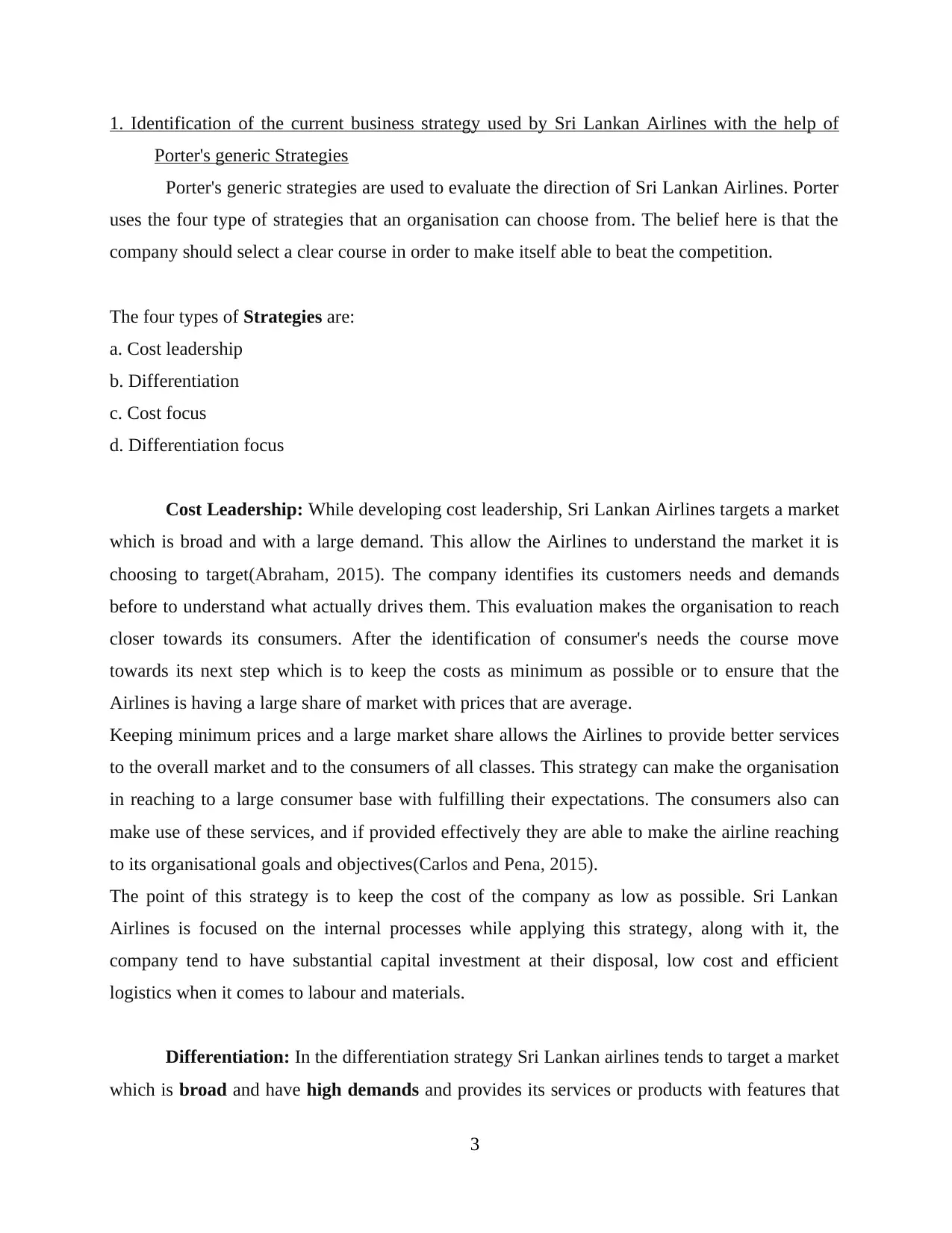
1. Identification of the current business strategy used by Sri Lankan Airlines with the help of
Porter's generic Strategies
Porter's generic strategies are used to evaluate the direction of Sri Lankan Airlines. Porter
uses the four type of strategies that an organisation can choose from. The belief here is that the
company should select a clear course in order to make itself able to beat the competition.
The four types of Strategies are:
a. Cost leadership
b. Differentiation
c. Cost focus
d. Differentiation focus
Cost Leadership: While developing cost leadership, Sri Lankan Airlines targets a market
which is broad and with a large demand. This allow the Airlines to understand the market it is
choosing to target(Abraham, 2015). The company identifies its customers needs and demands
before to understand what actually drives them. This evaluation makes the organisation to reach
closer towards its consumers. After the identification of consumer's needs the course move
towards its next step which is to keep the costs as minimum as possible or to ensure that the
Airlines is having a large share of market with prices that are average.
Keeping minimum prices and a large market share allows the Airlines to provide better services
to the overall market and to the consumers of all classes. This strategy can make the organisation
in reaching to a large consumer base with fulfilling their expectations. The consumers also can
make use of these services, and if provided effectively they are able to make the airline reaching
to its organisational goals and objectives(Carlos and Pena, 2015).
The point of this strategy is to keep the cost of the company as low as possible. Sri Lankan
Airlines is focused on the internal processes while applying this strategy, along with it, the
company tend to have substantial capital investment at their disposal, low cost and efficient
logistics when it comes to labour and materials.
Differentiation: In the differentiation strategy Sri Lankan airlines tends to target a market
which is broad and have high demands and provides its services or products with features that
3
Porter's generic Strategies
Porter's generic strategies are used to evaluate the direction of Sri Lankan Airlines. Porter
uses the four type of strategies that an organisation can choose from. The belief here is that the
company should select a clear course in order to make itself able to beat the competition.
The four types of Strategies are:
a. Cost leadership
b. Differentiation
c. Cost focus
d. Differentiation focus
Cost Leadership: While developing cost leadership, Sri Lankan Airlines targets a market
which is broad and with a large demand. This allow the Airlines to understand the market it is
choosing to target(Abraham, 2015). The company identifies its customers needs and demands
before to understand what actually drives them. This evaluation makes the organisation to reach
closer towards its consumers. After the identification of consumer's needs the course move
towards its next step which is to keep the costs as minimum as possible or to ensure that the
Airlines is having a large share of market with prices that are average.
Keeping minimum prices and a large market share allows the Airlines to provide better services
to the overall market and to the consumers of all classes. This strategy can make the organisation
in reaching to a large consumer base with fulfilling their expectations. The consumers also can
make use of these services, and if provided effectively they are able to make the airline reaching
to its organisational goals and objectives(Carlos and Pena, 2015).
The point of this strategy is to keep the cost of the company as low as possible. Sri Lankan
Airlines is focused on the internal processes while applying this strategy, along with it, the
company tend to have substantial capital investment at their disposal, low cost and efficient
logistics when it comes to labour and materials.
Differentiation: In the differentiation strategy Sri Lankan airlines tends to target a market
which is broad and have high demands and provides its services or products with features that
3
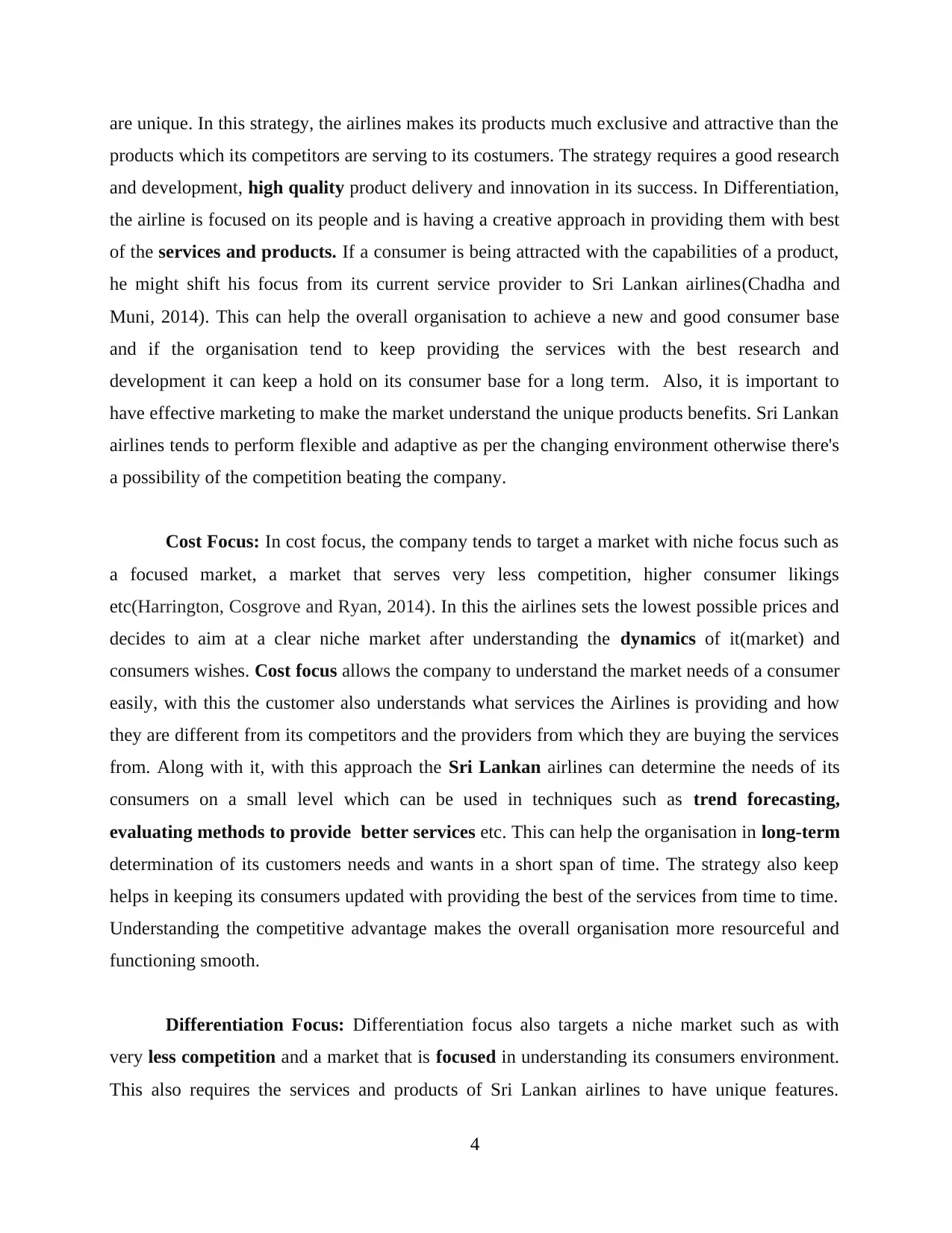
are unique. In this strategy, the airlines makes its products much exclusive and attractive than the
products which its competitors are serving to its costumers. The strategy requires a good research
and development, high quality product delivery and innovation in its success. In Differentiation,
the airline is focused on its people and is having a creative approach in providing them with best
of the services and products. If a consumer is being attracted with the capabilities of a product,
he might shift his focus from its current service provider to Sri Lankan airlines(Chadha and
Muni, 2014). This can help the overall organisation to achieve a new and good consumer base
and if the organisation tend to keep providing the services with the best research and
development it can keep a hold on its consumer base for a long term. Also, it is important to
have effective marketing to make the market understand the unique products benefits. Sri Lankan
airlines tends to perform flexible and adaptive as per the changing environment otherwise there's
a possibility of the competition beating the company.
Cost Focus: In cost focus, the company tends to target a market with niche focus such as
a focused market, a market that serves very less competition, higher consumer likings
etc(Harrington, Cosgrove and Ryan, 2014). In this the airlines sets the lowest possible prices and
decides to aim at a clear niche market after understanding the dynamics of it(market) and
consumers wishes. Cost focus allows the company to understand the market needs of a consumer
easily, with this the customer also understands what services the Airlines is providing and how
they are different from its competitors and the providers from which they are buying the services
from. Along with it, with this approach the Sri Lankan airlines can determine the needs of its
consumers on a small level which can be used in techniques such as trend forecasting,
evaluating methods to provide better services etc. This can help the organisation in long-term
determination of its customers needs and wants in a short span of time. The strategy also keep
helps in keeping its consumers updated with providing the best of the services from time to time.
Understanding the competitive advantage makes the overall organisation more resourceful and
functioning smooth.
Differentiation Focus: Differentiation focus also targets a niche market such as with
very less competition and a market that is focused in understanding its consumers environment.
This also requires the services and products of Sri Lankan airlines to have unique features.
4
products which its competitors are serving to its costumers. The strategy requires a good research
and development, high quality product delivery and innovation in its success. In Differentiation,
the airline is focused on its people and is having a creative approach in providing them with best
of the services and products. If a consumer is being attracted with the capabilities of a product,
he might shift his focus from its current service provider to Sri Lankan airlines(Chadha and
Muni, 2014). This can help the overall organisation to achieve a new and good consumer base
and if the organisation tend to keep providing the services with the best research and
development it can keep a hold on its consumer base for a long term. Also, it is important to
have effective marketing to make the market understand the unique products benefits. Sri Lankan
airlines tends to perform flexible and adaptive as per the changing environment otherwise there's
a possibility of the competition beating the company.
Cost Focus: In cost focus, the company tends to target a market with niche focus such as
a focused market, a market that serves very less competition, higher consumer likings
etc(Harrington, Cosgrove and Ryan, 2014). In this the airlines sets the lowest possible prices and
decides to aim at a clear niche market after understanding the dynamics of it(market) and
consumers wishes. Cost focus allows the company to understand the market needs of a consumer
easily, with this the customer also understands what services the Airlines is providing and how
they are different from its competitors and the providers from which they are buying the services
from. Along with it, with this approach the Sri Lankan airlines can determine the needs of its
consumers on a small level which can be used in techniques such as trend forecasting,
evaluating methods to provide better services etc. This can help the organisation in long-term
determination of its customers needs and wants in a short span of time. The strategy also keep
helps in keeping its consumers updated with providing the best of the services from time to time.
Understanding the competitive advantage makes the overall organisation more resourceful and
functioning smooth.
Differentiation Focus: Differentiation focus also targets a niche market such as with
very less competition and a market that is focused in understanding its consumers environment.
This also requires the services and products of Sri Lankan airlines to have unique features.
4
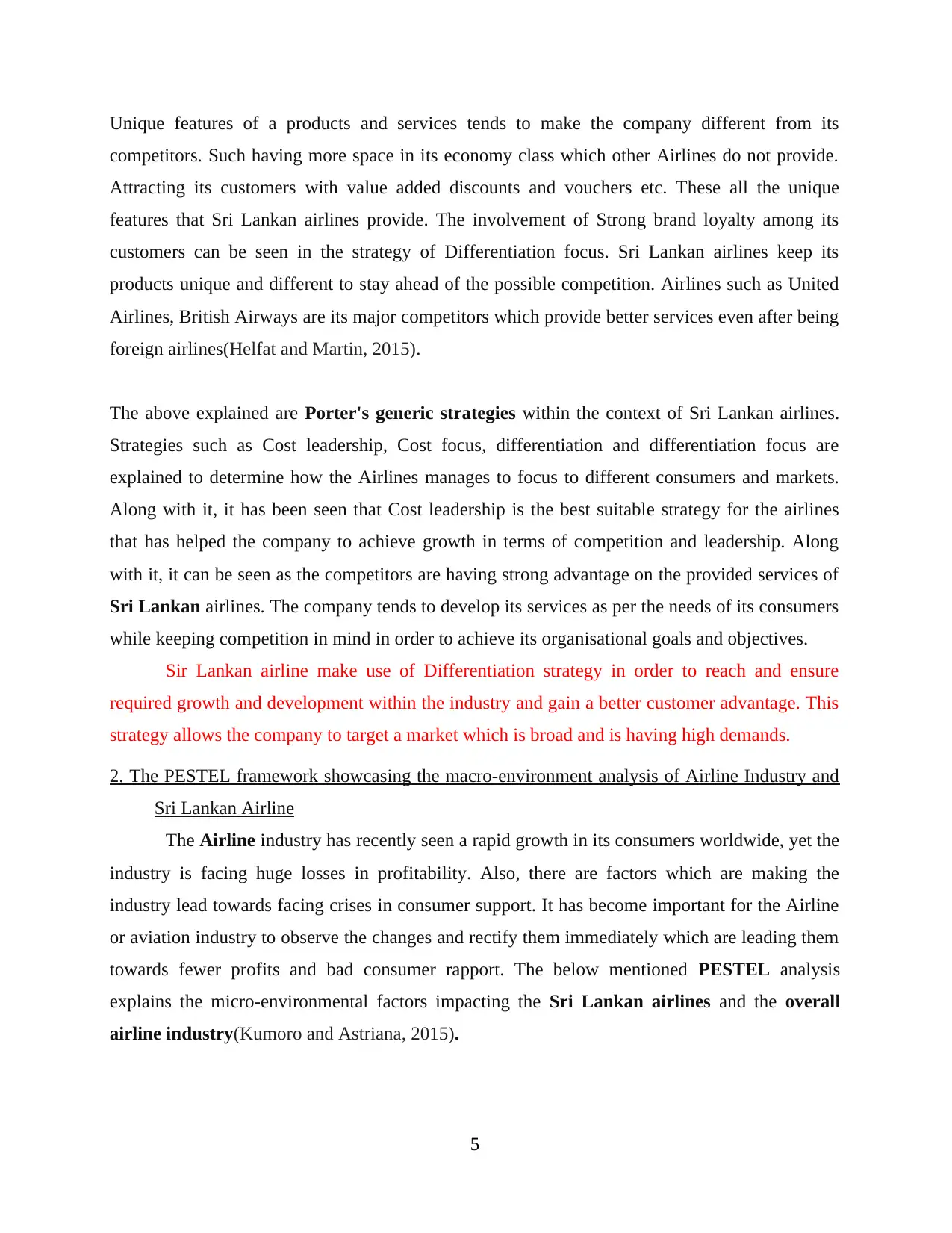
Unique features of a products and services tends to make the company different from its
competitors. Such having more space in its economy class which other Airlines do not provide.
Attracting its customers with value added discounts and vouchers etc. These all the unique
features that Sri Lankan airlines provide. The involvement of Strong brand loyalty among its
customers can be seen in the strategy of Differentiation focus. Sri Lankan airlines keep its
products unique and different to stay ahead of the possible competition. Airlines such as United
Airlines, British Airways are its major competitors which provide better services even after being
foreign airlines(Helfat and Martin, 2015).
The above explained are Porter's generic strategies within the context of Sri Lankan airlines.
Strategies such as Cost leadership, Cost focus, differentiation and differentiation focus are
explained to determine how the Airlines manages to focus to different consumers and markets.
Along with it, it has been seen that Cost leadership is the best suitable strategy for the airlines
that has helped the company to achieve growth in terms of competition and leadership. Along
with it, it can be seen as the competitors are having strong advantage on the provided services of
Sri Lankan airlines. The company tends to develop its services as per the needs of its consumers
while keeping competition in mind in order to achieve its organisational goals and objectives.
Sir Lankan airline make use of Differentiation strategy in order to reach and ensure
required growth and development within the industry and gain a better customer advantage. This
strategy allows the company to target a market which is broad and is having high demands.
2. The PESTEL framework showcasing the macro-environment analysis of Airline Industry and
Sri Lankan Airline
The Airline industry has recently seen a rapid growth in its consumers worldwide, yet the
industry is facing huge losses in profitability. Also, there are factors which are making the
industry lead towards facing crises in consumer support. It has become important for the Airline
or aviation industry to observe the changes and rectify them immediately which are leading them
towards fewer profits and bad consumer rapport. The below mentioned PESTEL analysis
explains the micro-environmental factors impacting the Sri Lankan airlines and the overall
airline industry(Kumoro and Astriana, 2015).
5
competitors. Such having more space in its economy class which other Airlines do not provide.
Attracting its customers with value added discounts and vouchers etc. These all the unique
features that Sri Lankan airlines provide. The involvement of Strong brand loyalty among its
customers can be seen in the strategy of Differentiation focus. Sri Lankan airlines keep its
products unique and different to stay ahead of the possible competition. Airlines such as United
Airlines, British Airways are its major competitors which provide better services even after being
foreign airlines(Helfat and Martin, 2015).
The above explained are Porter's generic strategies within the context of Sri Lankan airlines.
Strategies such as Cost leadership, Cost focus, differentiation and differentiation focus are
explained to determine how the Airlines manages to focus to different consumers and markets.
Along with it, it has been seen that Cost leadership is the best suitable strategy for the airlines
that has helped the company to achieve growth in terms of competition and leadership. Along
with it, it can be seen as the competitors are having strong advantage on the provided services of
Sri Lankan airlines. The company tends to develop its services as per the needs of its consumers
while keeping competition in mind in order to achieve its organisational goals and objectives.
Sir Lankan airline make use of Differentiation strategy in order to reach and ensure
required growth and development within the industry and gain a better customer advantage. This
strategy allows the company to target a market which is broad and is having high demands.
2. The PESTEL framework showcasing the macro-environment analysis of Airline Industry and
Sri Lankan Airline
The Airline industry has recently seen a rapid growth in its consumers worldwide, yet the
industry is facing huge losses in profitability. Also, there are factors which are making the
industry lead towards facing crises in consumer support. It has become important for the Airline
or aviation industry to observe the changes and rectify them immediately which are leading them
towards fewer profits and bad consumer rapport. The below mentioned PESTEL analysis
explains the micro-environmental factors impacting the Sri Lankan airlines and the overall
airline industry(Kumoro and Astriana, 2015).
5
Paraphrase This Document
Need a fresh take? Get an instant paraphrase of this document with our AI Paraphraser
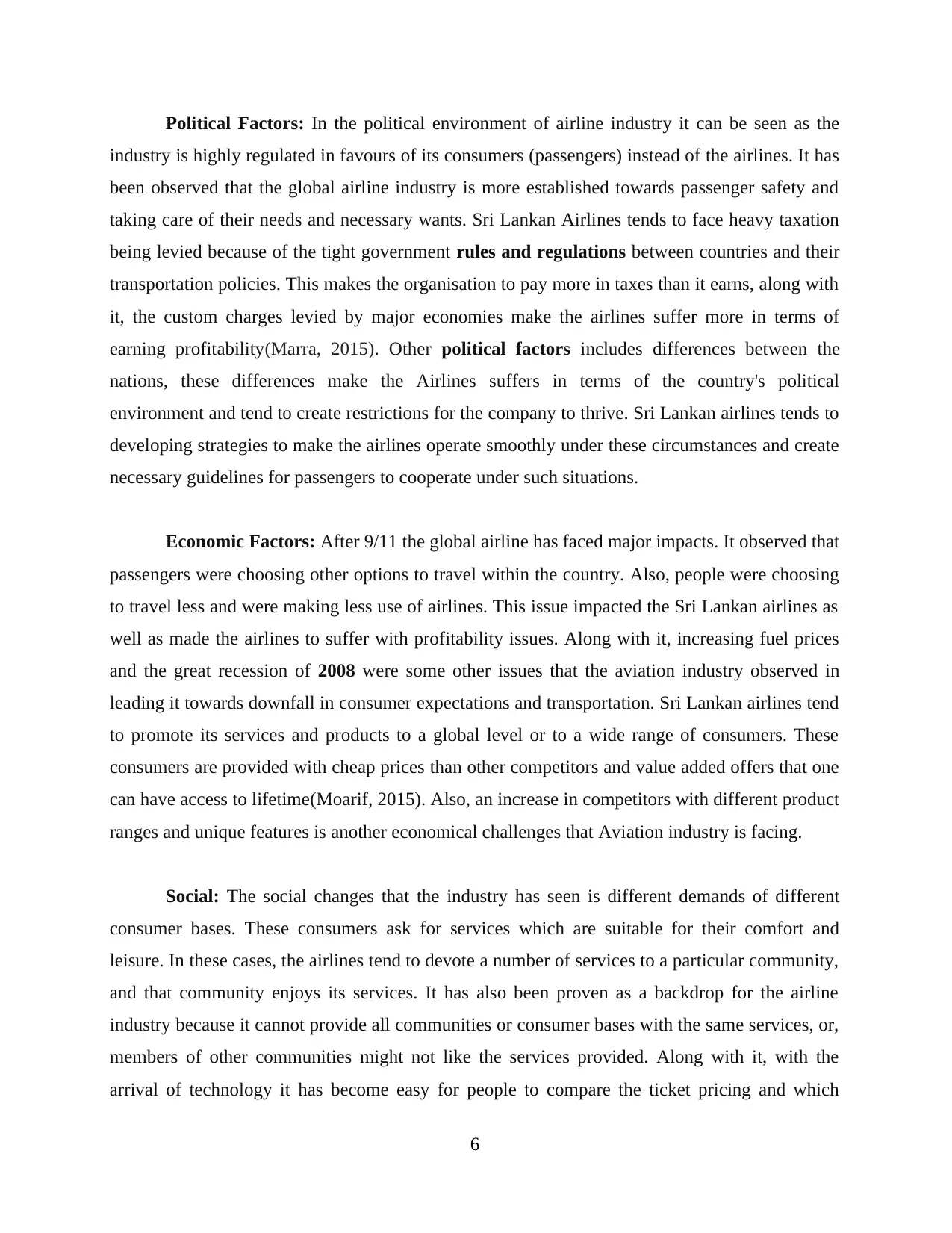
Political Factors: In the political environment of airline industry it can be seen as the
industry is highly regulated in favours of its consumers (passengers) instead of the airlines. It has
been observed that the global airline industry is more established towards passenger safety and
taking care of their needs and necessary wants. Sri Lankan Airlines tends to face heavy taxation
being levied because of the tight government rules and regulations between countries and their
transportation policies. This makes the organisation to pay more in taxes than it earns, along with
it, the custom charges levied by major economies make the airlines suffer more in terms of
earning profitability(Marra, 2015). Other political factors includes differences between the
nations, these differences make the Airlines suffers in terms of the country's political
environment and tend to create restrictions for the company to thrive. Sri Lankan airlines tends to
developing strategies to make the airlines operate smoothly under these circumstances and create
necessary guidelines for passengers to cooperate under such situations.
Economic Factors: After 9/11 the global airline has faced major impacts. It observed that
passengers were choosing other options to travel within the country. Also, people were choosing
to travel less and were making less use of airlines. This issue impacted the Sri Lankan airlines as
well as made the airlines to suffer with profitability issues. Along with it, increasing fuel prices
and the great recession of 2008 were some other issues that the aviation industry observed in
leading it towards downfall in consumer expectations and transportation. Sri Lankan airlines tend
to promote its services and products to a global level or to a wide range of consumers. These
consumers are provided with cheap prices than other competitors and value added offers that one
can have access to lifetime(Moarif, 2015). Also, an increase in competitors with different product
ranges and unique features is another economical challenges that Aviation industry is facing.
Social: The social changes that the industry has seen is different demands of different
consumer bases. These consumers ask for services which are suitable for their comfort and
leisure. In these cases, the airlines tend to devote a number of services to a particular community,
and that community enjoys its services. It has also been proven as a backdrop for the airline
industry because it cannot provide all communities or consumer bases with the same services, or,
members of other communities might not like the services provided. Along with it, with the
arrival of technology it has become easy for people to compare the ticket pricing and which
6
industry is highly regulated in favours of its consumers (passengers) instead of the airlines. It has
been observed that the global airline industry is more established towards passenger safety and
taking care of their needs and necessary wants. Sri Lankan Airlines tends to face heavy taxation
being levied because of the tight government rules and regulations between countries and their
transportation policies. This makes the organisation to pay more in taxes than it earns, along with
it, the custom charges levied by major economies make the airlines suffer more in terms of
earning profitability(Marra, 2015). Other political factors includes differences between the
nations, these differences make the Airlines suffers in terms of the country's political
environment and tend to create restrictions for the company to thrive. Sri Lankan airlines tends to
developing strategies to make the airlines operate smoothly under these circumstances and create
necessary guidelines for passengers to cooperate under such situations.
Economic Factors: After 9/11 the global airline has faced major impacts. It observed that
passengers were choosing other options to travel within the country. Also, people were choosing
to travel less and were making less use of airlines. This issue impacted the Sri Lankan airlines as
well as made the airlines to suffer with profitability issues. Along with it, increasing fuel prices
and the great recession of 2008 were some other issues that the aviation industry observed in
leading it towards downfall in consumer expectations and transportation. Sri Lankan airlines tend
to promote its services and products to a global level or to a wide range of consumers. These
consumers are provided with cheap prices than other competitors and value added offers that one
can have access to lifetime(Moarif, 2015). Also, an increase in competitors with different product
ranges and unique features is another economical challenges that Aviation industry is facing.
Social: The social changes that the industry has seen is different demands of different
consumer bases. These consumers ask for services which are suitable for their comfort and
leisure. In these cases, the airlines tend to devote a number of services to a particular community,
and that community enjoys its services. It has also been proven as a backdrop for the airline
industry because it cannot provide all communities or consumer bases with the same services, or,
members of other communities might not like the services provided. Along with it, with the
arrival of technology it has become easy for people to compare the ticket pricing and which
6
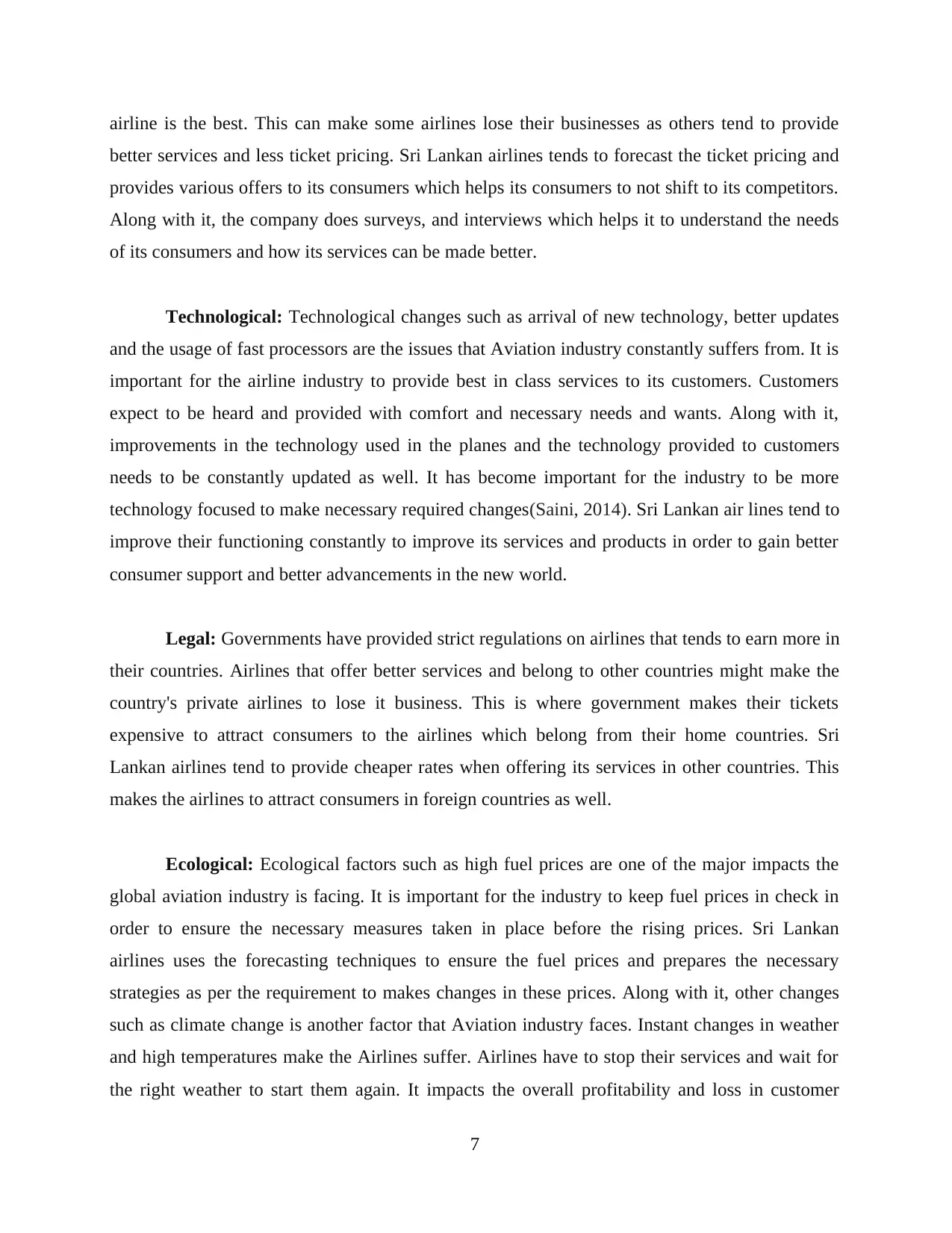
airline is the best. This can make some airlines lose their businesses as others tend to provide
better services and less ticket pricing. Sri Lankan airlines tends to forecast the ticket pricing and
provides various offers to its consumers which helps its consumers to not shift to its competitors.
Along with it, the company does surveys, and interviews which helps it to understand the needs
of its consumers and how its services can be made better.
Technological: Technological changes such as arrival of new technology, better updates
and the usage of fast processors are the issues that Aviation industry constantly suffers from. It is
important for the airline industry to provide best in class services to its customers. Customers
expect to be heard and provided with comfort and necessary needs and wants. Along with it,
improvements in the technology used in the planes and the technology provided to customers
needs to be constantly updated as well. It has become important for the industry to be more
technology focused to make necessary required changes(Saini, 2014). Sri Lankan air lines tend to
improve their functioning constantly to improve its services and products in order to gain better
consumer support and better advancements in the new world.
Legal: Governments have provided strict regulations on airlines that tends to earn more in
their countries. Airlines that offer better services and belong to other countries might make the
country's private airlines to lose it business. This is where government makes their tickets
expensive to attract consumers to the airlines which belong from their home countries. Sri
Lankan airlines tend to provide cheaper rates when offering its services in other countries. This
makes the airlines to attract consumers in foreign countries as well.
Ecological: Ecological factors such as high fuel prices are one of the major impacts the
global aviation industry is facing. It is important for the industry to keep fuel prices in check in
order to ensure the necessary measures taken in place before the rising prices. Sri Lankan
airlines uses the forecasting techniques to ensure the fuel prices and prepares the necessary
strategies as per the requirement to makes changes in these prices. Along with it, other changes
such as climate change is another factor that Aviation industry faces. Instant changes in weather
and high temperatures make the Airlines suffer. Airlines have to stop their services and wait for
the right weather to start them again. It impacts the overall profitability and loss in customer
7
better services and less ticket pricing. Sri Lankan airlines tends to forecast the ticket pricing and
provides various offers to its consumers which helps its consumers to not shift to its competitors.
Along with it, the company does surveys, and interviews which helps it to understand the needs
of its consumers and how its services can be made better.
Technological: Technological changes such as arrival of new technology, better updates
and the usage of fast processors are the issues that Aviation industry constantly suffers from. It is
important for the airline industry to provide best in class services to its customers. Customers
expect to be heard and provided with comfort and necessary needs and wants. Along with it,
improvements in the technology used in the planes and the technology provided to customers
needs to be constantly updated as well. It has become important for the industry to be more
technology focused to make necessary required changes(Saini, 2014). Sri Lankan air lines tend to
improve their functioning constantly to improve its services and products in order to gain better
consumer support and better advancements in the new world.
Legal: Governments have provided strict regulations on airlines that tends to earn more in
their countries. Airlines that offer better services and belong to other countries might make the
country's private airlines to lose it business. This is where government makes their tickets
expensive to attract consumers to the airlines which belong from their home countries. Sri
Lankan airlines tend to provide cheaper rates when offering its services in other countries. This
makes the airlines to attract consumers in foreign countries as well.
Ecological: Ecological factors such as high fuel prices are one of the major impacts the
global aviation industry is facing. It is important for the industry to keep fuel prices in check in
order to ensure the necessary measures taken in place before the rising prices. Sri Lankan
airlines uses the forecasting techniques to ensure the fuel prices and prepares the necessary
strategies as per the requirement to makes changes in these prices. Along with it, other changes
such as climate change is another factor that Aviation industry faces. Instant changes in weather
and high temperatures make the Airlines suffer. Airlines have to stop their services and wait for
the right weather to start them again. It impacts the overall profitability and loss in customer
7
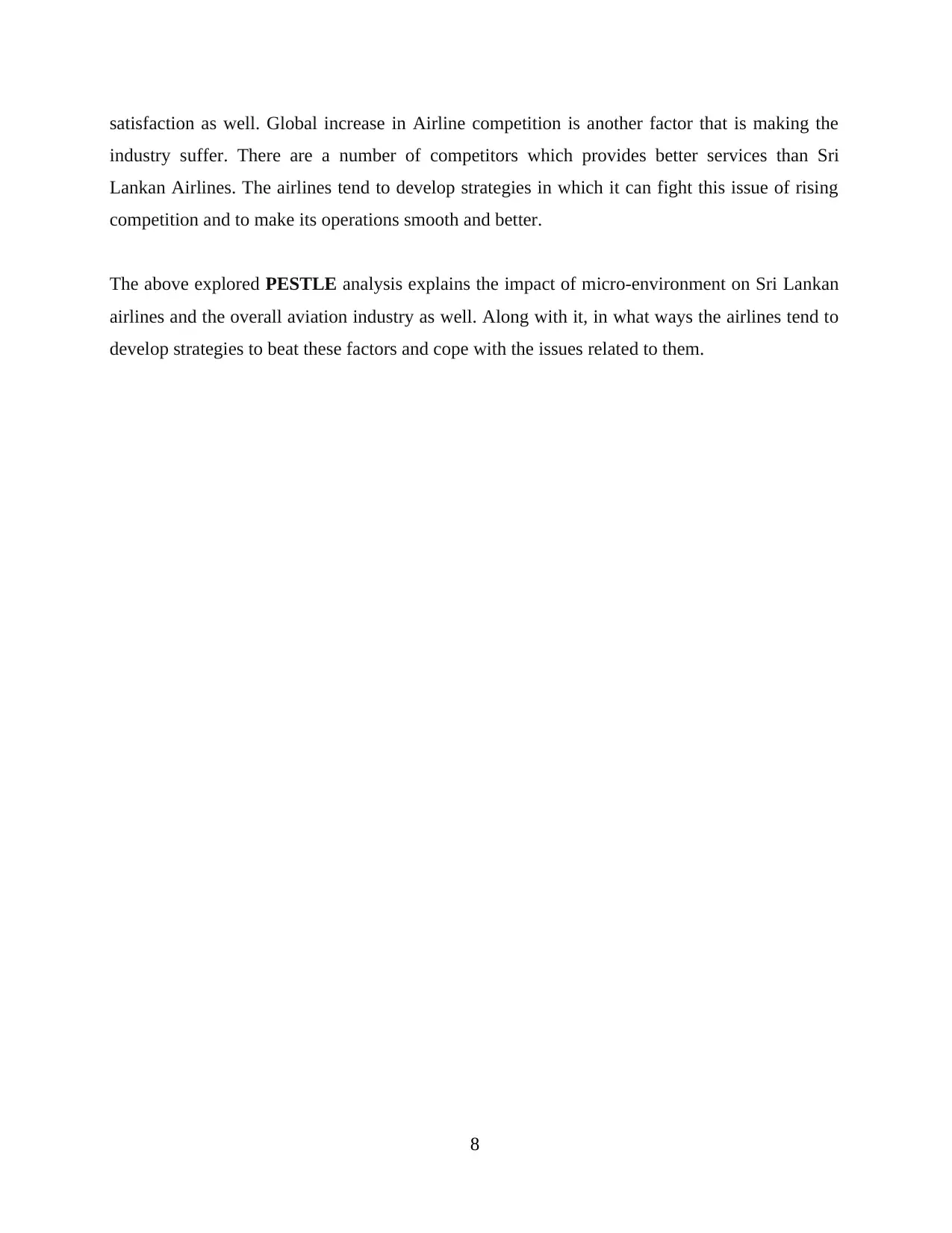
satisfaction as well. Global increase in Airline competition is another factor that is making the
industry suffer. There are a number of competitors which provides better services than Sri
Lankan Airlines. The airlines tend to develop strategies in which it can fight this issue of rising
competition and to make its operations smooth and better.
The above explored PESTLE analysis explains the impact of micro-environment on Sri Lankan
airlines and the overall aviation industry as well. Along with it, in what ways the airlines tend to
develop strategies to beat these factors and cope with the issues related to them.
8
industry suffer. There are a number of competitors which provides better services than Sri
Lankan Airlines. The airlines tend to develop strategies in which it can fight this issue of rising
competition and to make its operations smooth and better.
The above explored PESTLE analysis explains the impact of micro-environment on Sri Lankan
airlines and the overall aviation industry as well. Along with it, in what ways the airlines tend to
develop strategies to beat these factors and cope with the issues related to them.
8
Secure Best Marks with AI Grader
Need help grading? Try our AI Grader for instant feedback on your assignments.
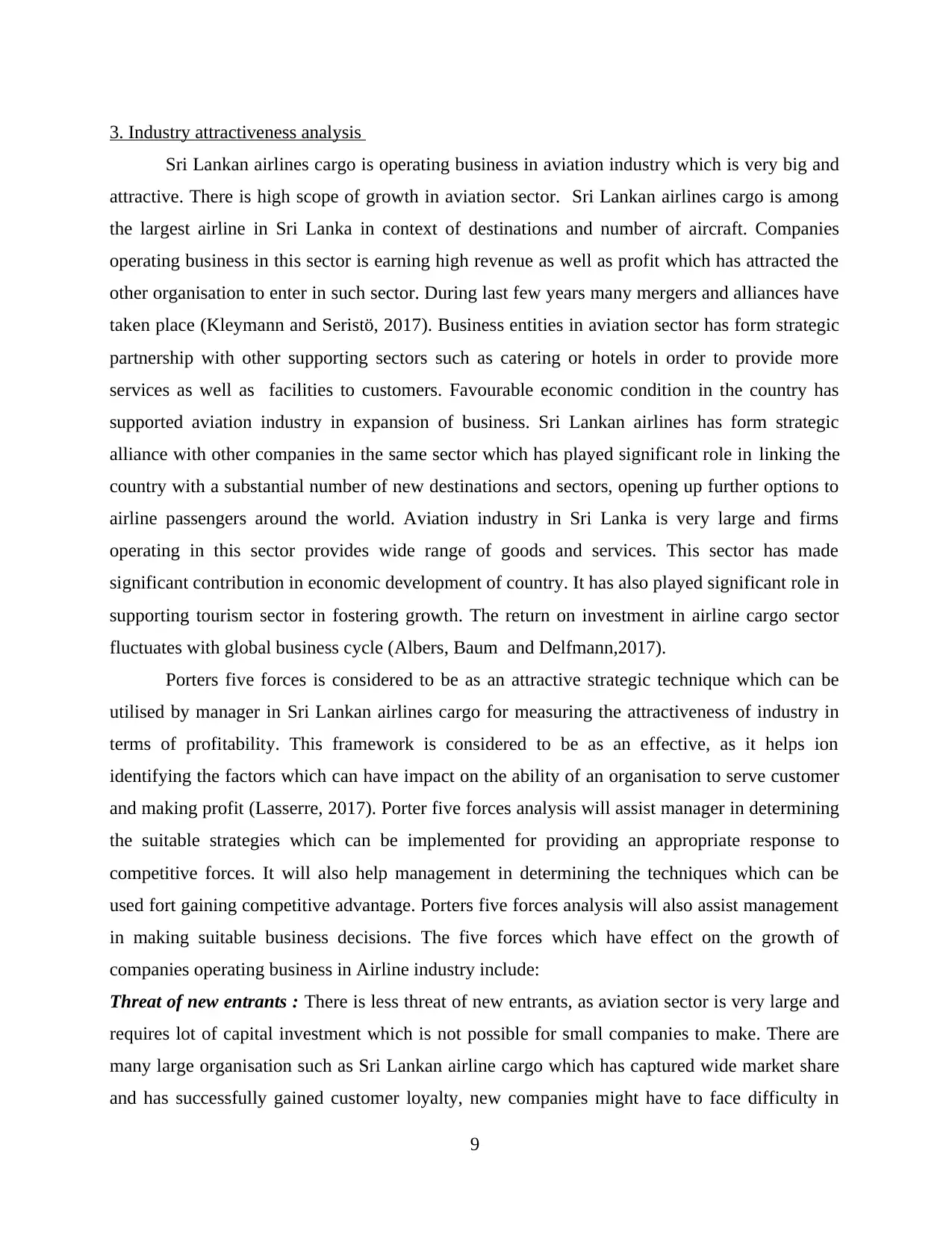
3. Industry attractiveness analysis
Sri Lankan airlines cargo is operating business in aviation industry which is very big and
attractive. There is high scope of growth in aviation sector. Sri Lankan airlines cargo is among
the largest airline in Sri Lanka in context of destinations and number of aircraft. Companies
operating business in this sector is earning high revenue as well as profit which has attracted the
other organisation to enter in such sector. During last few years many mergers and alliances have
taken place (Kleymann and Seristö, 2017). Business entities in aviation sector has form strategic
partnership with other supporting sectors such as catering or hotels in order to provide more
services as well as facilities to customers. Favourable economic condition in the country has
supported aviation industry in expansion of business. Sri Lankan airlines has form strategic
alliance with other companies in the same sector which has played significant role in linking the
country with a substantial number of new destinations and sectors, opening up further options to
airline passengers around the world. Aviation industry in Sri Lanka is very large and firms
operating in this sector provides wide range of goods and services. This sector has made
significant contribution in economic development of country. It has also played significant role in
supporting tourism sector in fostering growth. The return on investment in airline cargo sector
fluctuates with global business cycle (Albers, Baum and Delfmann,2017).
Porters five forces is considered to be as an attractive strategic technique which can be
utilised by manager in Sri Lankan airlines cargo for measuring the attractiveness of industry in
terms of profitability. This framework is considered to be as an effective, as it helps ion
identifying the factors which can have impact on the ability of an organisation to serve customer
and making profit (Lasserre, 2017). Porter five forces analysis will assist manager in determining
the suitable strategies which can be implemented for providing an appropriate response to
competitive forces. It will also help management in determining the techniques which can be
used fort gaining competitive advantage. Porters five forces analysis will also assist management
in making suitable business decisions. The five forces which have effect on the growth of
companies operating business in Airline industry include:
Threat of new entrants : There is less threat of new entrants, as aviation sector is very large and
requires lot of capital investment which is not possible for small companies to make. There are
many large organisation such as Sri Lankan airline cargo which has captured wide market share
and has successfully gained customer loyalty, new companies might have to face difficulty in
9
Sri Lankan airlines cargo is operating business in aviation industry which is very big and
attractive. There is high scope of growth in aviation sector. Sri Lankan airlines cargo is among
the largest airline in Sri Lanka in context of destinations and number of aircraft. Companies
operating business in this sector is earning high revenue as well as profit which has attracted the
other organisation to enter in such sector. During last few years many mergers and alliances have
taken place (Kleymann and Seristö, 2017). Business entities in aviation sector has form strategic
partnership with other supporting sectors such as catering or hotels in order to provide more
services as well as facilities to customers. Favourable economic condition in the country has
supported aviation industry in expansion of business. Sri Lankan airlines has form strategic
alliance with other companies in the same sector which has played significant role in linking the
country with a substantial number of new destinations and sectors, opening up further options to
airline passengers around the world. Aviation industry in Sri Lanka is very large and firms
operating in this sector provides wide range of goods and services. This sector has made
significant contribution in economic development of country. It has also played significant role in
supporting tourism sector in fostering growth. The return on investment in airline cargo sector
fluctuates with global business cycle (Albers, Baum and Delfmann,2017).
Porters five forces is considered to be as an attractive strategic technique which can be
utilised by manager in Sri Lankan airlines cargo for measuring the attractiveness of industry in
terms of profitability. This framework is considered to be as an effective, as it helps ion
identifying the factors which can have impact on the ability of an organisation to serve customer
and making profit (Lasserre, 2017). Porter five forces analysis will assist manager in determining
the suitable strategies which can be implemented for providing an appropriate response to
competitive forces. It will also help management in determining the techniques which can be
used fort gaining competitive advantage. Porters five forces analysis will also assist management
in making suitable business decisions. The five forces which have effect on the growth of
companies operating business in Airline industry include:
Threat of new entrants : There is less threat of new entrants, as aviation sector is very large and
requires lot of capital investment which is not possible for small companies to make. There are
many large organisation such as Sri Lankan airline cargo which has captured wide market share
and has successfully gained customer loyalty, new companies might have to face difficulty in
9
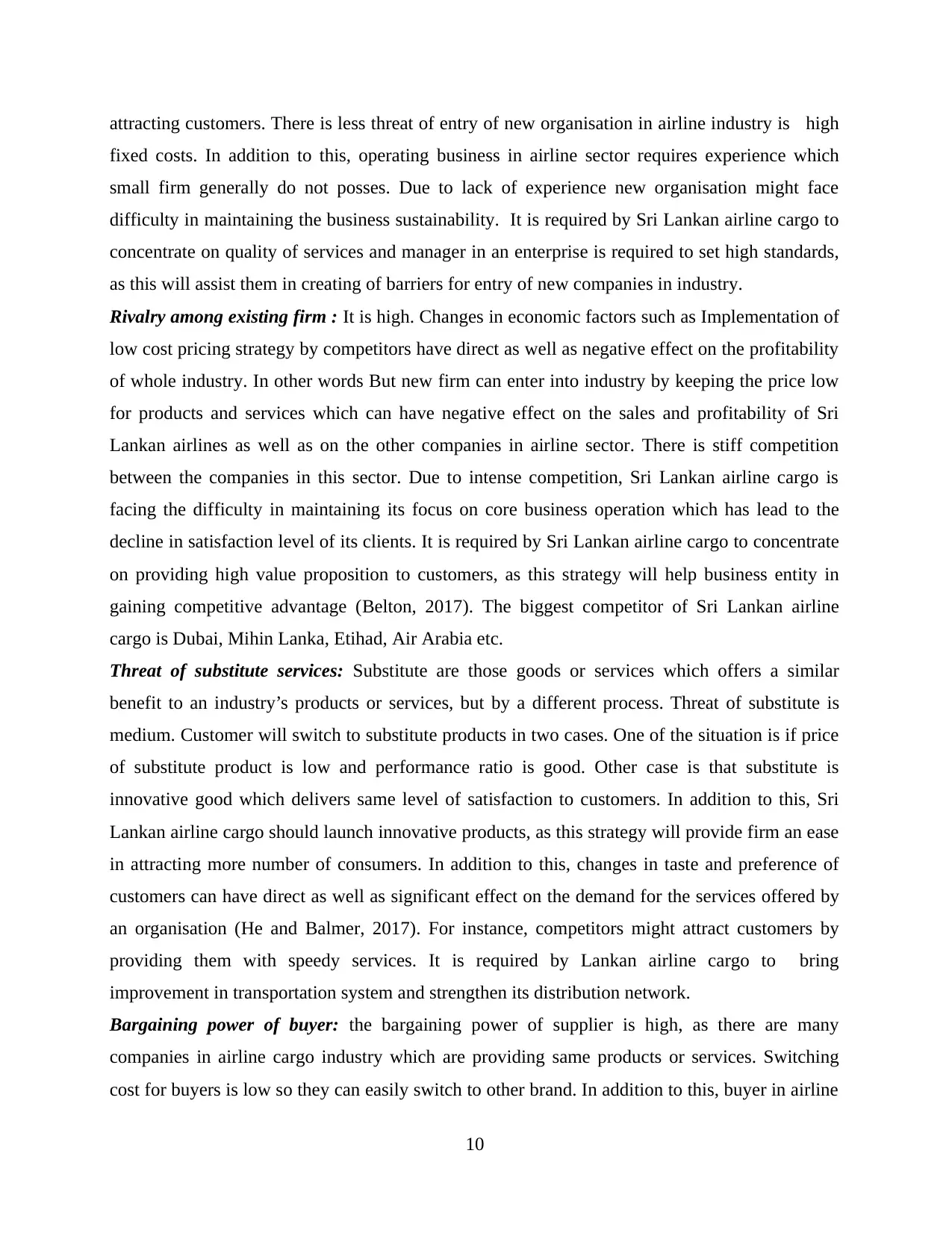
attracting customers. There is less threat of entry of new organisation in airline industry is high
fixed costs. In addition to this, operating business in airline sector requires experience which
small firm generally do not posses. Due to lack of experience new organisation might face
difficulty in maintaining the business sustainability. It is required by Sri Lankan airline cargo to
concentrate on quality of services and manager in an enterprise is required to set high standards,
as this will assist them in creating of barriers for entry of new companies in industry.
Rivalry among existing firm : It is high. Changes in economic factors such as Implementation of
low cost pricing strategy by competitors have direct as well as negative effect on the profitability
of whole industry. In other words But new firm can enter into industry by keeping the price low
for products and services which can have negative effect on the sales and profitability of Sri
Lankan airlines as well as on the other companies in airline sector. There is stiff competition
between the companies in this sector. Due to intense competition, Sri Lankan airline cargo is
facing the difficulty in maintaining its focus on core business operation which has lead to the
decline in satisfaction level of its clients. It is required by Sri Lankan airline cargo to concentrate
on providing high value proposition to customers, as this strategy will help business entity in
gaining competitive advantage (Belton, 2017). The biggest competitor of Sri Lankan airline
cargo is Dubai, Mihin Lanka, Etihad, Air Arabia etc.
Threat of substitute services: Substitute are those goods or services which offers a similar
benefit to an industry’s products or services, but by a different process. Threat of substitute is
medium. Customer will switch to substitute products in two cases. One of the situation is if price
of substitute product is low and performance ratio is good. Other case is that substitute is
innovative good which delivers same level of satisfaction to customers. In addition to this, Sri
Lankan airline cargo should launch innovative products, as this strategy will provide firm an ease
in attracting more number of consumers. In addition to this, changes in taste and preference of
customers can have direct as well as significant effect on the demand for the services offered by
an organisation (He and Balmer, 2017). For instance, competitors might attract customers by
providing them with speedy services. It is required by Lankan airline cargo to bring
improvement in transportation system and strengthen its distribution network.
Bargaining power of buyer: the bargaining power of supplier is high, as there are many
companies in airline cargo industry which are providing same products or services. Switching
cost for buyers is low so they can easily switch to other brand. In addition to this, buyer in airline
10
fixed costs. In addition to this, operating business in airline sector requires experience which
small firm generally do not posses. Due to lack of experience new organisation might face
difficulty in maintaining the business sustainability. It is required by Sri Lankan airline cargo to
concentrate on quality of services and manager in an enterprise is required to set high standards,
as this will assist them in creating of barriers for entry of new companies in industry.
Rivalry among existing firm : It is high. Changes in economic factors such as Implementation of
low cost pricing strategy by competitors have direct as well as negative effect on the profitability
of whole industry. In other words But new firm can enter into industry by keeping the price low
for products and services which can have negative effect on the sales and profitability of Sri
Lankan airlines as well as on the other companies in airline sector. There is stiff competition
between the companies in this sector. Due to intense competition, Sri Lankan airline cargo is
facing the difficulty in maintaining its focus on core business operation which has lead to the
decline in satisfaction level of its clients. It is required by Sri Lankan airline cargo to concentrate
on providing high value proposition to customers, as this strategy will help business entity in
gaining competitive advantage (Belton, 2017). The biggest competitor of Sri Lankan airline
cargo is Dubai, Mihin Lanka, Etihad, Air Arabia etc.
Threat of substitute services: Substitute are those goods or services which offers a similar
benefit to an industry’s products or services, but by a different process. Threat of substitute is
medium. Customer will switch to substitute products in two cases. One of the situation is if price
of substitute product is low and performance ratio is good. Other case is that substitute is
innovative good which delivers same level of satisfaction to customers. In addition to this, Sri
Lankan airline cargo should launch innovative products, as this strategy will provide firm an ease
in attracting more number of consumers. In addition to this, changes in taste and preference of
customers can have direct as well as significant effect on the demand for the services offered by
an organisation (He and Balmer, 2017). For instance, competitors might attract customers by
providing them with speedy services. It is required by Lankan airline cargo to bring
improvement in transportation system and strengthen its distribution network.
Bargaining power of buyer: the bargaining power of supplier is high, as there are many
companies in airline cargo industry which are providing same products or services. Switching
cost for buyers is low so they can easily switch to other brand. In addition to this, buyer in airline
10
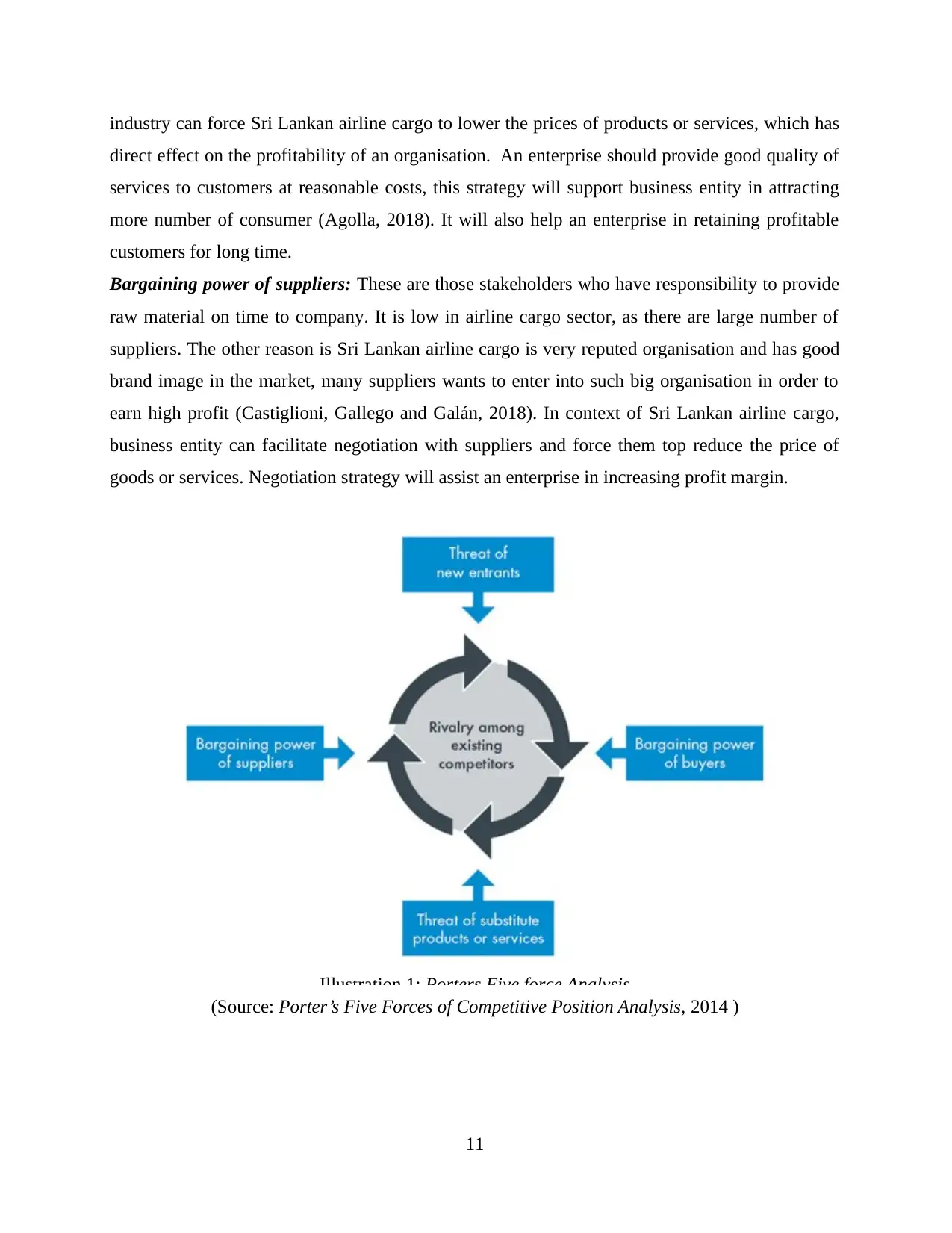
industry can force Sri Lankan airline cargo to lower the prices of products or services, which has
direct effect on the profitability of an organisation. An enterprise should provide good quality of
services to customers at reasonable costs, this strategy will support business entity in attracting
more number of consumer (Agolla, 2018). It will also help an enterprise in retaining profitable
customers for long time.
Bargaining power of suppliers: These are those stakeholders who have responsibility to provide
raw material on time to company. It is low in airline cargo sector, as there are large number of
suppliers. The other reason is Sri Lankan airline cargo is very reputed organisation and has good
brand image in the market, many suppliers wants to enter into such big organisation in order to
earn high profit (Castiglioni, Gallego and Galán, 2018). In context of Sri Lankan airline cargo,
business entity can facilitate negotiation with suppliers and force them top reduce the price of
goods or services. Negotiation strategy will assist an enterprise in increasing profit margin.
(Source: Porter’s Five Forces of Competitive Position Analysis, 2014 )
11
Illustration 1: Porters Five force Analysis
direct effect on the profitability of an organisation. An enterprise should provide good quality of
services to customers at reasonable costs, this strategy will support business entity in attracting
more number of consumer (Agolla, 2018). It will also help an enterprise in retaining profitable
customers for long time.
Bargaining power of suppliers: These are those stakeholders who have responsibility to provide
raw material on time to company. It is low in airline cargo sector, as there are large number of
suppliers. The other reason is Sri Lankan airline cargo is very reputed organisation and has good
brand image in the market, many suppliers wants to enter into such big organisation in order to
earn high profit (Castiglioni, Gallego and Galán, 2018). In context of Sri Lankan airline cargo,
business entity can facilitate negotiation with suppliers and force them top reduce the price of
goods or services. Negotiation strategy will assist an enterprise in increasing profit margin.
(Source: Porter’s Five Forces of Competitive Position Analysis, 2014 )
11
Illustration 1: Porters Five force Analysis
Paraphrase This Document
Need a fresh take? Get an instant paraphrase of this document with our AI Paraphraser
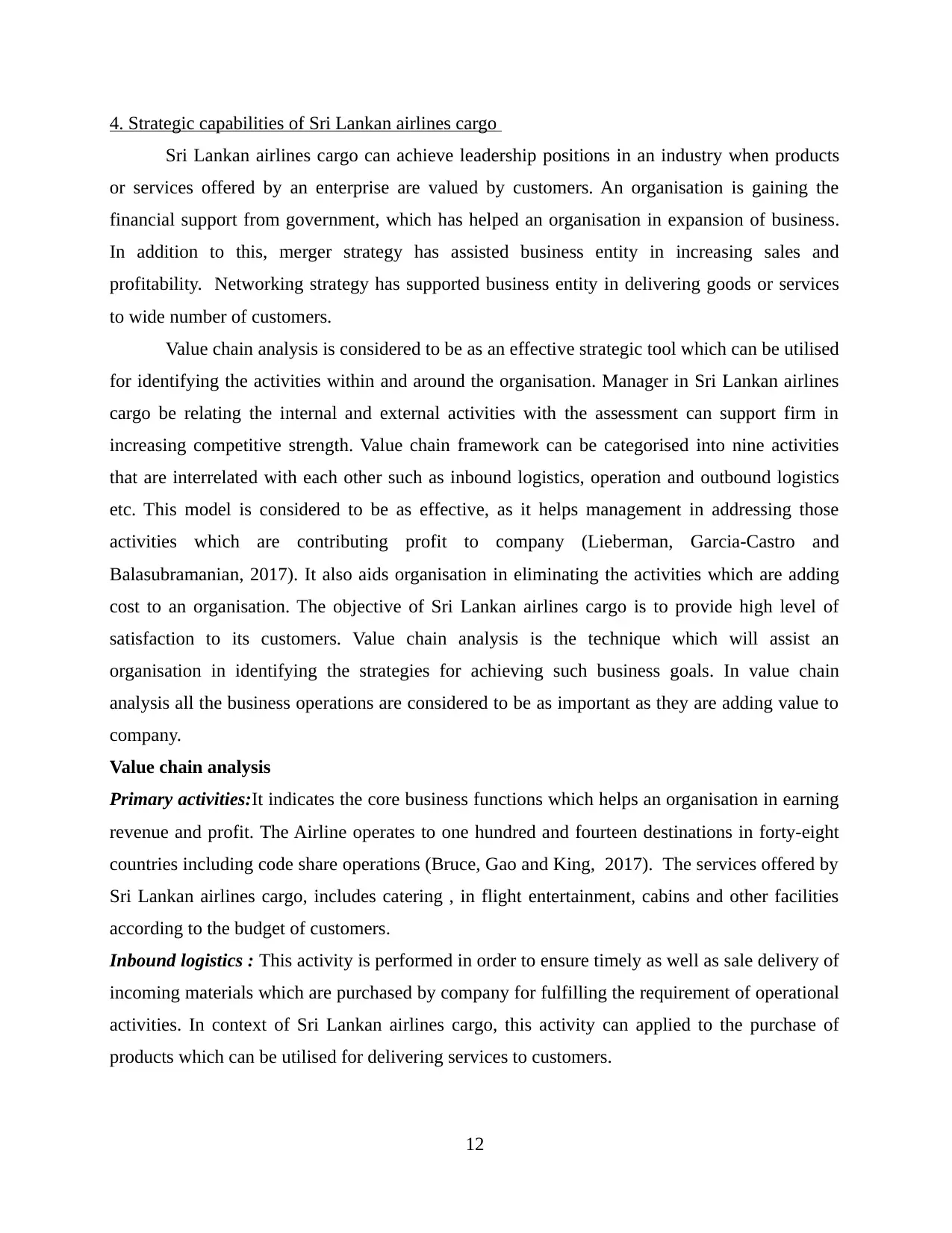
4. Strategic capabilities of Sri Lankan airlines cargo
Sri Lankan airlines cargo can achieve leadership positions in an industry when products
or services offered by an enterprise are valued by customers. An organisation is gaining the
financial support from government, which has helped an organisation in expansion of business.
In addition to this, merger strategy has assisted business entity in increasing sales and
profitability. Networking strategy has supported business entity in delivering goods or services
to wide number of customers.
Value chain analysis is considered to be as an effective strategic tool which can be utilised
for identifying the activities within and around the organisation. Manager in Sri Lankan airlines
cargo be relating the internal and external activities with the assessment can support firm in
increasing competitive strength. Value chain framework can be categorised into nine activities
that are interrelated with each other such as inbound logistics, operation and outbound logistics
etc. This model is considered to be as effective, as it helps management in addressing those
activities which are contributing profit to company (Lieberman, Garcia‐Castro and
Balasubramanian, 2017). It also aids organisation in eliminating the activities which are adding
cost to an organisation. The objective of Sri Lankan airlines cargo is to provide high level of
satisfaction to its customers. Value chain analysis is the technique which will assist an
organisation in identifying the strategies for achieving such business goals. In value chain
analysis all the business operations are considered to be as important as they are adding value to
company.
Value chain analysis
Primary activities:It indicates the core business functions which helps an organisation in earning
revenue and profit. The Airline operates to one hundred and fourteen destinations in forty-eight
countries including code share operations (Bruce, Gao and King, 2017). The services offered by
Sri Lankan airlines cargo, includes catering , in flight entertainment, cabins and other facilities
according to the budget of customers.
Inbound logistics : This activity is performed in order to ensure timely as well as sale delivery of
incoming materials which are purchased by company for fulfilling the requirement of operational
activities. In context of Sri Lankan airlines cargo, this activity can applied to the purchase of
products which can be utilised for delivering services to customers.
12
Sri Lankan airlines cargo can achieve leadership positions in an industry when products
or services offered by an enterprise are valued by customers. An organisation is gaining the
financial support from government, which has helped an organisation in expansion of business.
In addition to this, merger strategy has assisted business entity in increasing sales and
profitability. Networking strategy has supported business entity in delivering goods or services
to wide number of customers.
Value chain analysis is considered to be as an effective strategic tool which can be utilised
for identifying the activities within and around the organisation. Manager in Sri Lankan airlines
cargo be relating the internal and external activities with the assessment can support firm in
increasing competitive strength. Value chain framework can be categorised into nine activities
that are interrelated with each other such as inbound logistics, operation and outbound logistics
etc. This model is considered to be as effective, as it helps management in addressing those
activities which are contributing profit to company (Lieberman, Garcia‐Castro and
Balasubramanian, 2017). It also aids organisation in eliminating the activities which are adding
cost to an organisation. The objective of Sri Lankan airlines cargo is to provide high level of
satisfaction to its customers. Value chain analysis is the technique which will assist an
organisation in identifying the strategies for achieving such business goals. In value chain
analysis all the business operations are considered to be as important as they are adding value to
company.
Value chain analysis
Primary activities:It indicates the core business functions which helps an organisation in earning
revenue and profit. The Airline operates to one hundred and fourteen destinations in forty-eight
countries including code share operations (Bruce, Gao and King, 2017). The services offered by
Sri Lankan airlines cargo, includes catering , in flight entertainment, cabins and other facilities
according to the budget of customers.
Inbound logistics : This activity is performed in order to ensure timely as well as sale delivery of
incoming materials which are purchased by company for fulfilling the requirement of operational
activities. In context of Sri Lankan airlines cargo, this activity can applied to the purchase of
products which can be utilised for delivering services to customers.
12
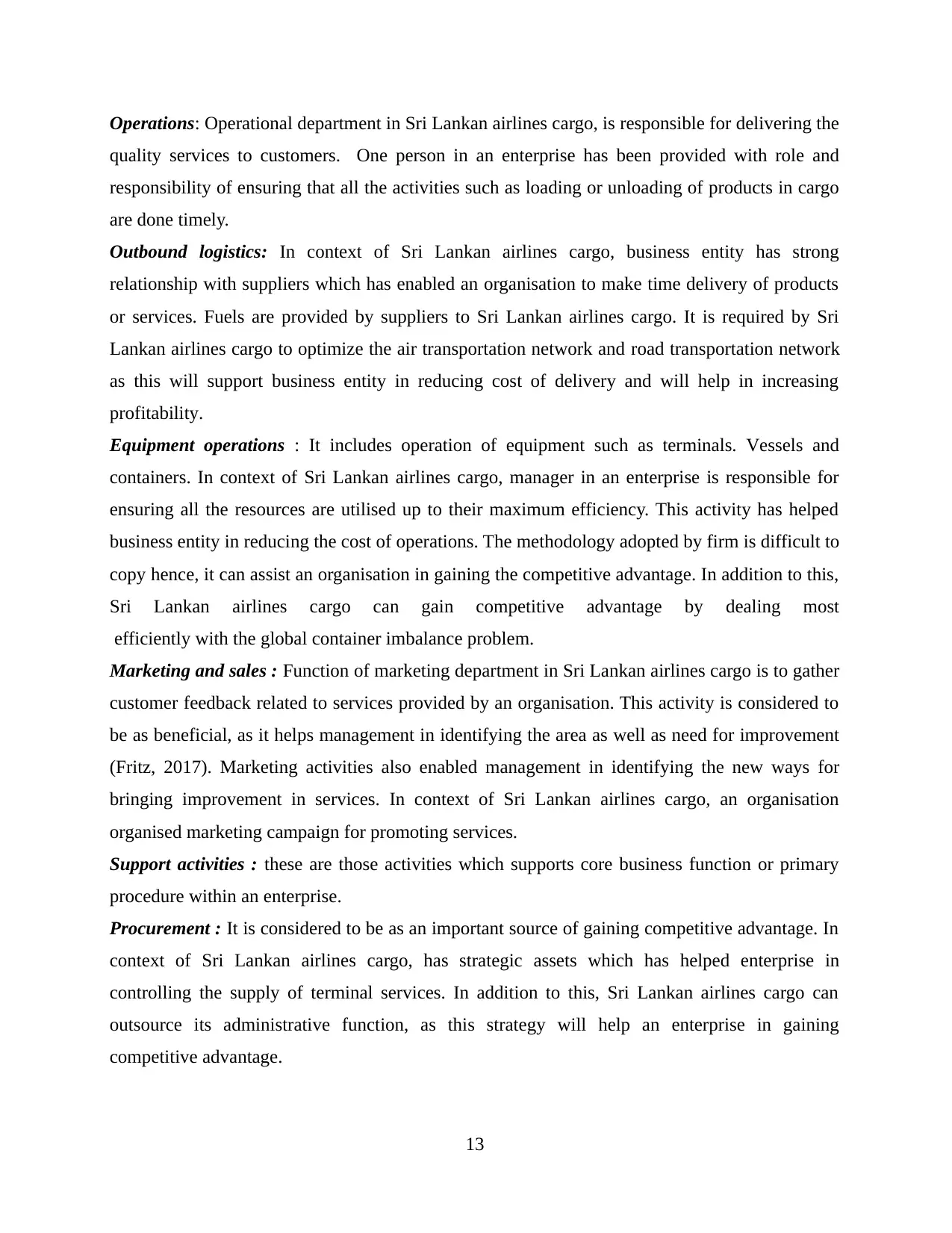
Operations: Operational department in Sri Lankan airlines cargo, is responsible for delivering the
quality services to customers. One person in an enterprise has been provided with role and
responsibility of ensuring that all the activities such as loading or unloading of products in cargo
are done timely.
Outbound logistics: In context of Sri Lankan airlines cargo, business entity has strong
relationship with suppliers which has enabled an organisation to make time delivery of products
or services. Fuels are provided by suppliers to Sri Lankan airlines cargo. It is required by Sri
Lankan airlines cargo to optimize the air transportation network and road transportation network
as this will support business entity in reducing cost of delivery and will help in increasing
profitability.
Equipment operations : It includes operation of equipment such as terminals. Vessels and
containers. In context of Sri Lankan airlines cargo, manager in an enterprise is responsible for
ensuring all the resources are utilised up to their maximum efficiency. This activity has helped
business entity in reducing the cost of operations. The methodology adopted by firm is difficult to
copy hence, it can assist an organisation in gaining the competitive advantage. In addition to this,
Sri Lankan airlines cargo can gain competitive advantage by dealing most
efficiently with the global container imbalance problem.
Marketing and sales : Function of marketing department in Sri Lankan airlines cargo is to gather
customer feedback related to services provided by an organisation. This activity is considered to
be as beneficial, as it helps management in identifying the area as well as need for improvement
(Fritz, 2017). Marketing activities also enabled management in identifying the new ways for
bringing improvement in services. In context of Sri Lankan airlines cargo, an organisation
organised marketing campaign for promoting services.
Support activities : these are those activities which supports core business function or primary
procedure within an enterprise.
Procurement : It is considered to be as an important source of gaining competitive advantage. In
context of Sri Lankan airlines cargo, has strategic assets which has helped enterprise in
controlling the supply of terminal services. In addition to this, Sri Lankan airlines cargo can
outsource its administrative function, as this strategy will help an enterprise in gaining
competitive advantage.
13
quality services to customers. One person in an enterprise has been provided with role and
responsibility of ensuring that all the activities such as loading or unloading of products in cargo
are done timely.
Outbound logistics: In context of Sri Lankan airlines cargo, business entity has strong
relationship with suppliers which has enabled an organisation to make time delivery of products
or services. Fuels are provided by suppliers to Sri Lankan airlines cargo. It is required by Sri
Lankan airlines cargo to optimize the air transportation network and road transportation network
as this will support business entity in reducing cost of delivery and will help in increasing
profitability.
Equipment operations : It includes operation of equipment such as terminals. Vessels and
containers. In context of Sri Lankan airlines cargo, manager in an enterprise is responsible for
ensuring all the resources are utilised up to their maximum efficiency. This activity has helped
business entity in reducing the cost of operations. The methodology adopted by firm is difficult to
copy hence, it can assist an organisation in gaining the competitive advantage. In addition to this,
Sri Lankan airlines cargo can gain competitive advantage by dealing most
efficiently with the global container imbalance problem.
Marketing and sales : Function of marketing department in Sri Lankan airlines cargo is to gather
customer feedback related to services provided by an organisation. This activity is considered to
be as beneficial, as it helps management in identifying the area as well as need for improvement
(Fritz, 2017). Marketing activities also enabled management in identifying the new ways for
bringing improvement in services. In context of Sri Lankan airlines cargo, an organisation
organised marketing campaign for promoting services.
Support activities : these are those activities which supports core business function or primary
procedure within an enterprise.
Procurement : It is considered to be as an important source of gaining competitive advantage. In
context of Sri Lankan airlines cargo, has strategic assets which has helped enterprise in
controlling the supply of terminal services. In addition to this, Sri Lankan airlines cargo can
outsource its administrative function, as this strategy will help an enterprise in gaining
competitive advantage.
13
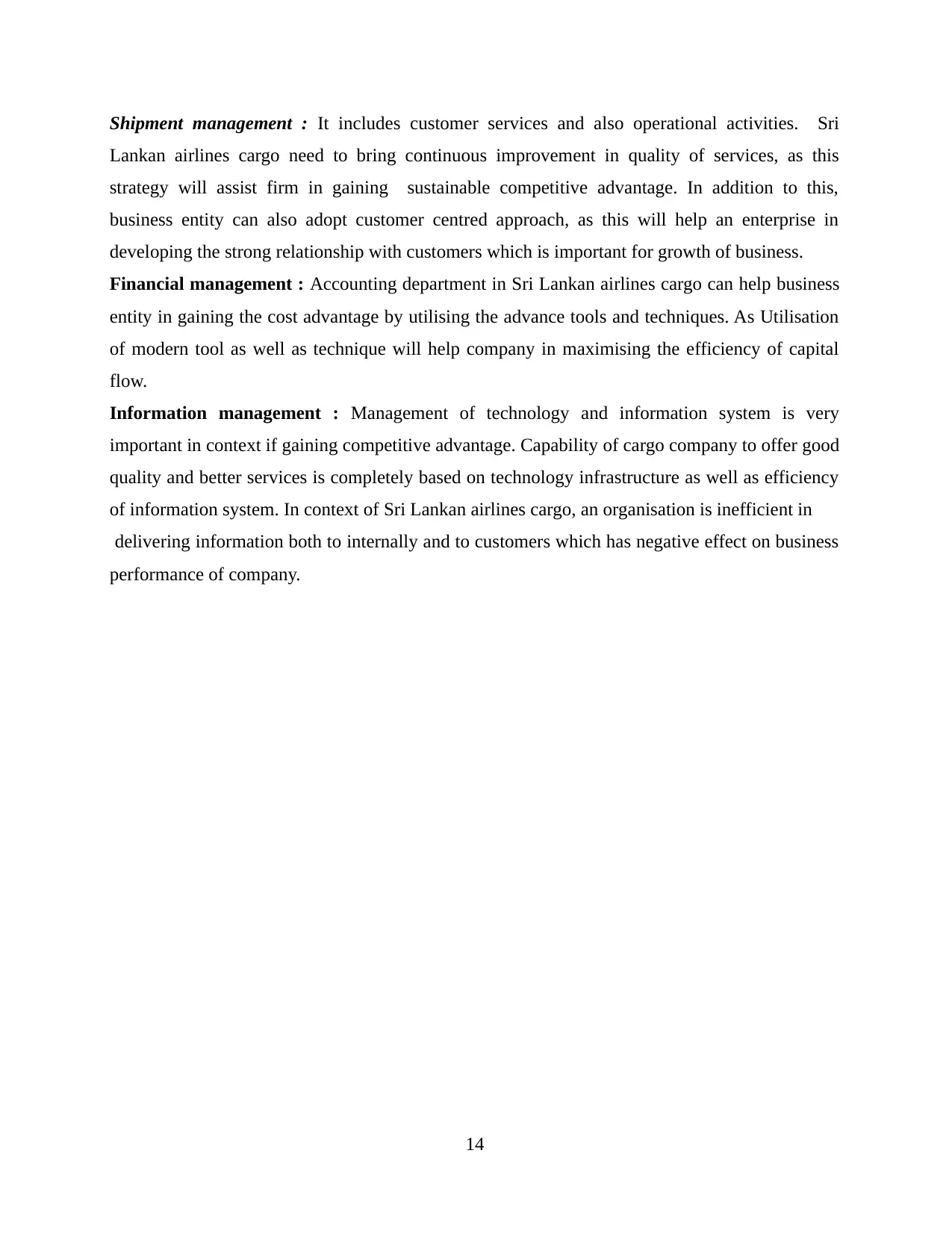
Shipment management : It includes customer services and also operational activities. Sri
Lankan airlines cargo need to bring continuous improvement in quality of services, as this
strategy will assist firm in gaining sustainable competitive advantage. In addition to this,
business entity can also adopt customer centred approach, as this will help an enterprise in
developing the strong relationship with customers which is important for growth of business.
Financial management : Accounting department in Sri Lankan airlines cargo can help business
entity in gaining the cost advantage by utilising the advance tools and techniques. As Utilisation
of modern tool as well as technique will help company in maximising the efficiency of capital
flow.
Information management : Management of technology and information system is very
important in context if gaining competitive advantage. Capability of cargo company to offer good
quality and better services is completely based on technology infrastructure as well as efficiency
of information system. In context of Sri Lankan airlines cargo, an organisation is inefficient in
delivering information both to internally and to customers which has negative effect on business
performance of company.
14
Lankan airlines cargo need to bring continuous improvement in quality of services, as this
strategy will assist firm in gaining sustainable competitive advantage. In addition to this,
business entity can also adopt customer centred approach, as this will help an enterprise in
developing the strong relationship with customers which is important for growth of business.
Financial management : Accounting department in Sri Lankan airlines cargo can help business
entity in gaining the cost advantage by utilising the advance tools and techniques. As Utilisation
of modern tool as well as technique will help company in maximising the efficiency of capital
flow.
Information management : Management of technology and information system is very
important in context if gaining competitive advantage. Capability of cargo company to offer good
quality and better services is completely based on technology infrastructure as well as efficiency
of information system. In context of Sri Lankan airlines cargo, an organisation is inefficient in
delivering information both to internally and to customers which has negative effect on business
performance of company.
14
Secure Best Marks with AI Grader
Need help grading? Try our AI Grader for instant feedback on your assignments.
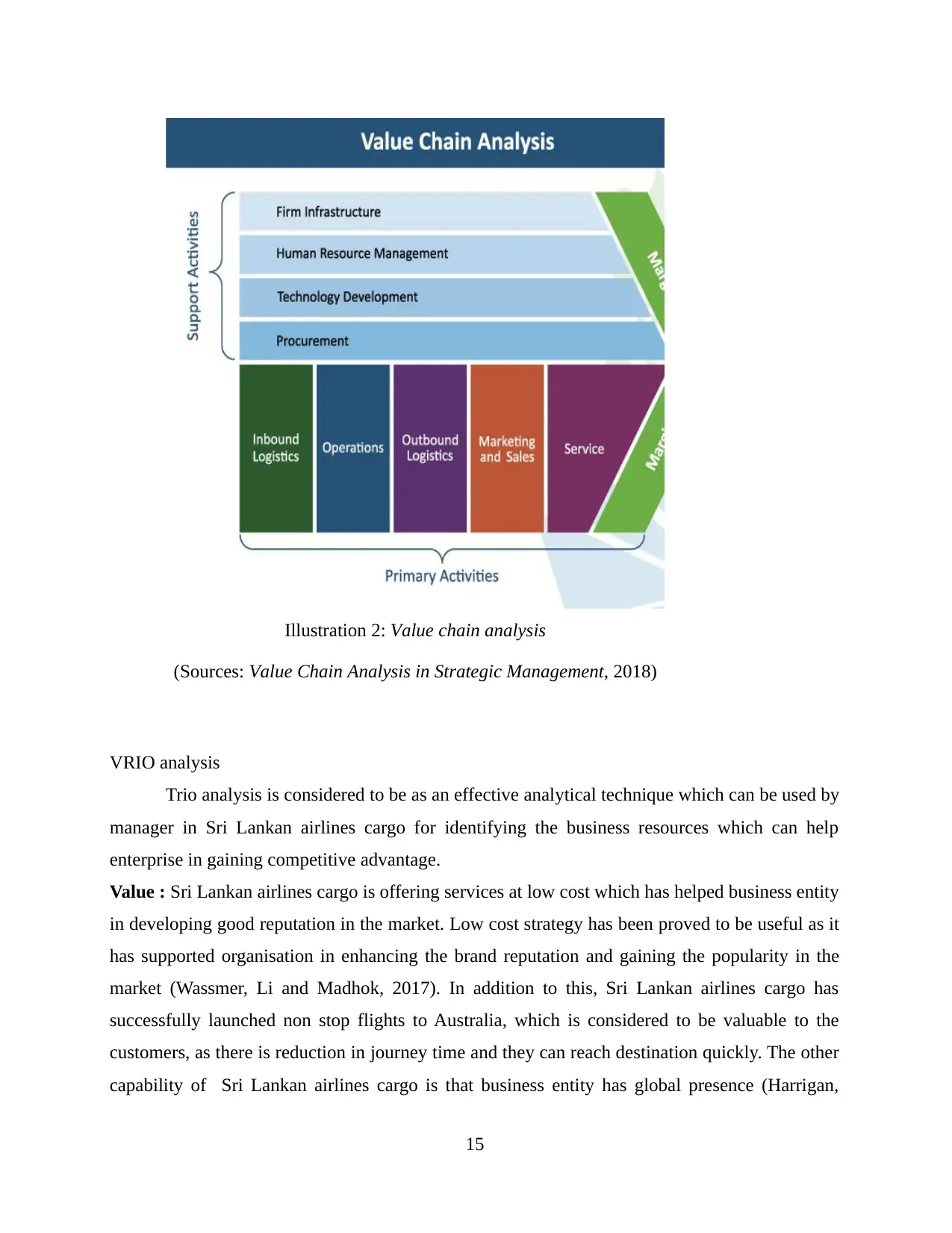
VRIO analysis
Trio analysis is considered to be as an effective analytical technique which can be used by
manager in Sri Lankan airlines cargo for identifying the business resources which can help
enterprise in gaining competitive advantage.
Value : Sri Lankan airlines cargo is offering services at low cost which has helped business entity
in developing good reputation in the market. Low cost strategy has been proved to be useful as it
has supported organisation in enhancing the brand reputation and gaining the popularity in the
market (Wassmer, Li and Madhok, 2017). In addition to this, Sri Lankan airlines cargo has
successfully launched non stop flights to Australia, which is considered to be valuable to the
customers, as there is reduction in journey time and they can reach destination quickly. The other
capability of Sri Lankan airlines cargo is that business entity has global presence (Harrigan,
15
Illustration 2: Value chain analysis
(Sources: Value Chain Analysis in Strategic Management, 2018)
Trio analysis is considered to be as an effective analytical technique which can be used by
manager in Sri Lankan airlines cargo for identifying the business resources which can help
enterprise in gaining competitive advantage.
Value : Sri Lankan airlines cargo is offering services at low cost which has helped business entity
in developing good reputation in the market. Low cost strategy has been proved to be useful as it
has supported organisation in enhancing the brand reputation and gaining the popularity in the
market (Wassmer, Li and Madhok, 2017). In addition to this, Sri Lankan airlines cargo has
successfully launched non stop flights to Australia, which is considered to be valuable to the
customers, as there is reduction in journey time and they can reach destination quickly. The other
capability of Sri Lankan airlines cargo is that business entity has global presence (Harrigan,
15
Illustration 2: Value chain analysis
(Sources: Value Chain Analysis in Strategic Management, 2018)
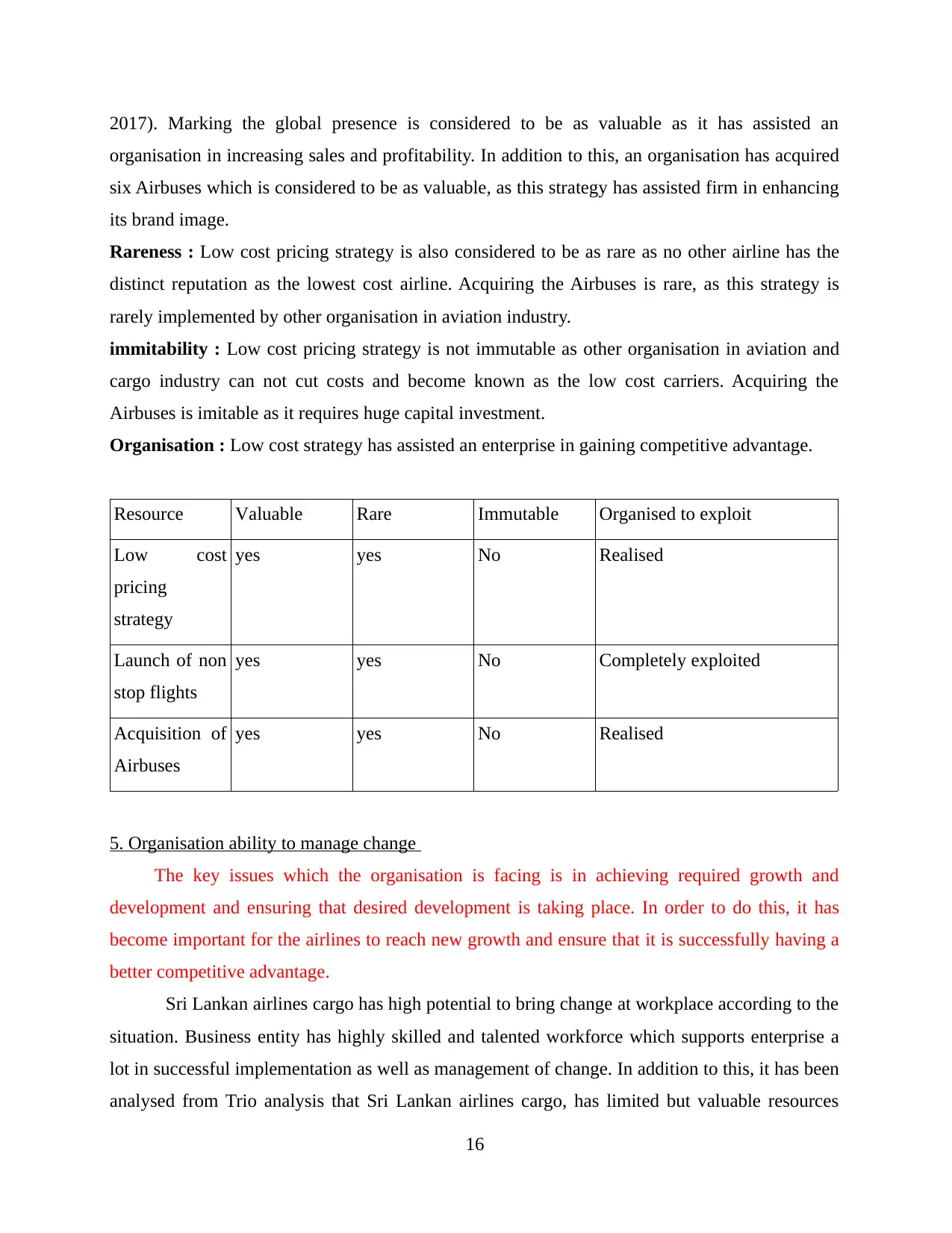
2017). Marking the global presence is considered to be as valuable as it has assisted an
organisation in increasing sales and profitability. In addition to this, an organisation has acquired
six Airbuses which is considered to be as valuable, as this strategy has assisted firm in enhancing
its brand image.
Rareness : Low cost pricing strategy is also considered to be as rare as no other airline has the
distinct reputation as the lowest cost airline. Acquiring the Airbuses is rare, as this strategy is
rarely implemented by other organisation in aviation industry.
immitability : Low cost pricing strategy is not immutable as other organisation in aviation and
cargo industry can not cut costs and become known as the low cost carriers. Acquiring the
Airbuses is imitable as it requires huge capital investment.
Organisation : Low cost strategy has assisted an enterprise in gaining competitive advantage.
Resource Valuable Rare Immutable Organised to exploit
Low cost
pricing
strategy
yes yes No Realised
Launch of non
stop flights
yes yes No Completely exploited
Acquisition of
Airbuses
yes yes No Realised
5. Organisation ability to manage change
The key issues which the organisation is facing is in achieving required growth and
development and ensuring that desired development is taking place. In order to do this, it has
become important for the airlines to reach new growth and ensure that it is successfully having a
better competitive advantage.
Sri Lankan airlines cargo has high potential to bring change at workplace according to the
situation. Business entity has highly skilled and talented workforce which supports enterprise a
lot in successful implementation as well as management of change. In addition to this, it has been
analysed from Trio analysis that Sri Lankan airlines cargo, has limited but valuable resources
16
organisation in increasing sales and profitability. In addition to this, an organisation has acquired
six Airbuses which is considered to be as valuable, as this strategy has assisted firm in enhancing
its brand image.
Rareness : Low cost pricing strategy is also considered to be as rare as no other airline has the
distinct reputation as the lowest cost airline. Acquiring the Airbuses is rare, as this strategy is
rarely implemented by other organisation in aviation industry.
immitability : Low cost pricing strategy is not immutable as other organisation in aviation and
cargo industry can not cut costs and become known as the low cost carriers. Acquiring the
Airbuses is imitable as it requires huge capital investment.
Organisation : Low cost strategy has assisted an enterprise in gaining competitive advantage.
Resource Valuable Rare Immutable Organised to exploit
Low cost
pricing
strategy
yes yes No Realised
Launch of non
stop flights
yes yes No Completely exploited
Acquisition of
Airbuses
yes yes No Realised
5. Organisation ability to manage change
The key issues which the organisation is facing is in achieving required growth and
development and ensuring that desired development is taking place. In order to do this, it has
become important for the airlines to reach new growth and ensure that it is successfully having a
better competitive advantage.
Sri Lankan airlines cargo has high potential to bring change at workplace according to the
situation. Business entity has highly skilled and talented workforce which supports enterprise a
lot in successful implementation as well as management of change. In addition to this, it has been
analysed from Trio analysis that Sri Lankan airlines cargo, has limited but valuable resources
16
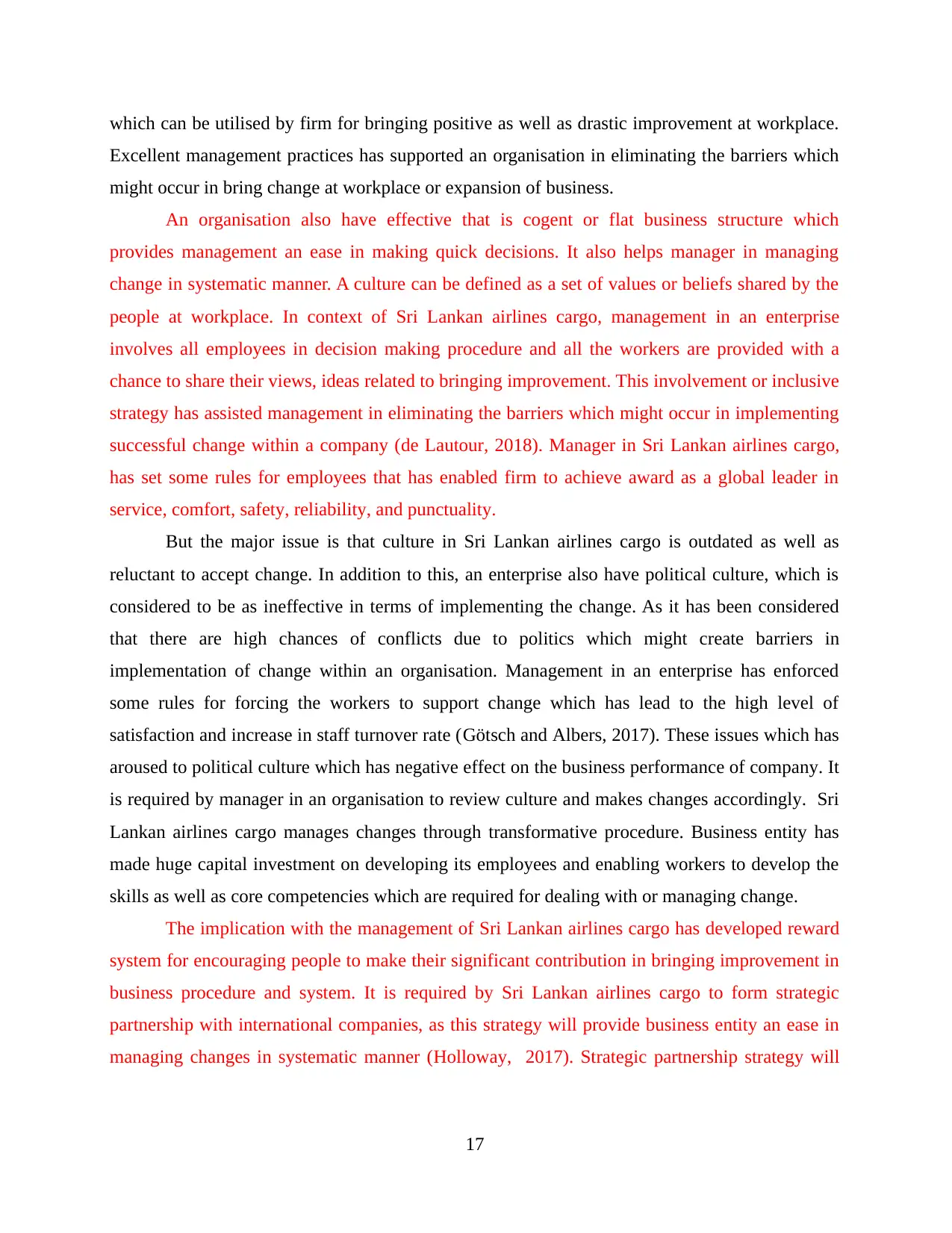
which can be utilised by firm for bringing positive as well as drastic improvement at workplace.
Excellent management practices has supported an organisation in eliminating the barriers which
might occur in bring change at workplace or expansion of business.
An organisation also have effective that is cogent or flat business structure which
provides management an ease in making quick decisions. It also helps manager in managing
change in systematic manner. A culture can be defined as a set of values or beliefs shared by the
people at workplace. In context of Sri Lankan airlines cargo, management in an enterprise
involves all employees in decision making procedure and all the workers are provided with a
chance to share their views, ideas related to bringing improvement. This involvement or inclusive
strategy has assisted management in eliminating the barriers which might occur in implementing
successful change within a company (de Lautour, 2018). Manager in Sri Lankan airlines cargo,
has set some rules for employees that has enabled firm to achieve award as a global leader in
service, comfort, safety, reliability, and punctuality.
But the major issue is that culture in Sri Lankan airlines cargo is outdated as well as
reluctant to accept change. In addition to this, an enterprise also have political culture, which is
considered to be as ineffective in terms of implementing the change. As it has been considered
that there are high chances of conflicts due to politics which might create barriers in
implementation of change within an organisation. Management in an enterprise has enforced
some rules for forcing the workers to support change which has lead to the high level of
satisfaction and increase in staff turnover rate (Götsch and Albers, 2017). These issues which has
aroused to political culture which has negative effect on the business performance of company. It
is required by manager in an organisation to review culture and makes changes accordingly. Sri
Lankan airlines cargo manages changes through transformative procedure. Business entity has
made huge capital investment on developing its employees and enabling workers to develop the
skills as well as core competencies which are required for dealing with or managing change.
The implication with the management of Sri Lankan airlines cargo has developed reward
system for encouraging people to make their significant contribution in bringing improvement in
business procedure and system. It is required by Sri Lankan airlines cargo to form strategic
partnership with international companies, as this strategy will provide business entity an ease in
managing changes in systematic manner (Holloway, 2017). Strategic partnership strategy will
17
Excellent management practices has supported an organisation in eliminating the barriers which
might occur in bring change at workplace or expansion of business.
An organisation also have effective that is cogent or flat business structure which
provides management an ease in making quick decisions. It also helps manager in managing
change in systematic manner. A culture can be defined as a set of values or beliefs shared by the
people at workplace. In context of Sri Lankan airlines cargo, management in an enterprise
involves all employees in decision making procedure and all the workers are provided with a
chance to share their views, ideas related to bringing improvement. This involvement or inclusive
strategy has assisted management in eliminating the barriers which might occur in implementing
successful change within a company (de Lautour, 2018). Manager in Sri Lankan airlines cargo,
has set some rules for employees that has enabled firm to achieve award as a global leader in
service, comfort, safety, reliability, and punctuality.
But the major issue is that culture in Sri Lankan airlines cargo is outdated as well as
reluctant to accept change. In addition to this, an enterprise also have political culture, which is
considered to be as ineffective in terms of implementing the change. As it has been considered
that there are high chances of conflicts due to politics which might create barriers in
implementation of change within an organisation. Management in an enterprise has enforced
some rules for forcing the workers to support change which has lead to the high level of
satisfaction and increase in staff turnover rate (Götsch and Albers, 2017). These issues which has
aroused to political culture which has negative effect on the business performance of company. It
is required by manager in an organisation to review culture and makes changes accordingly. Sri
Lankan airlines cargo manages changes through transformative procedure. Business entity has
made huge capital investment on developing its employees and enabling workers to develop the
skills as well as core competencies which are required for dealing with or managing change.
The implication with the management of Sri Lankan airlines cargo has developed reward
system for encouraging people to make their significant contribution in bringing improvement in
business procedure and system. It is required by Sri Lankan airlines cargo to form strategic
partnership with international companies, as this strategy will provide business entity an ease in
managing changes in systematic manner (Holloway, 2017). Strategic partnership strategy will
17
Paraphrase This Document
Need a fresh take? Get an instant paraphrase of this document with our AI Paraphraser
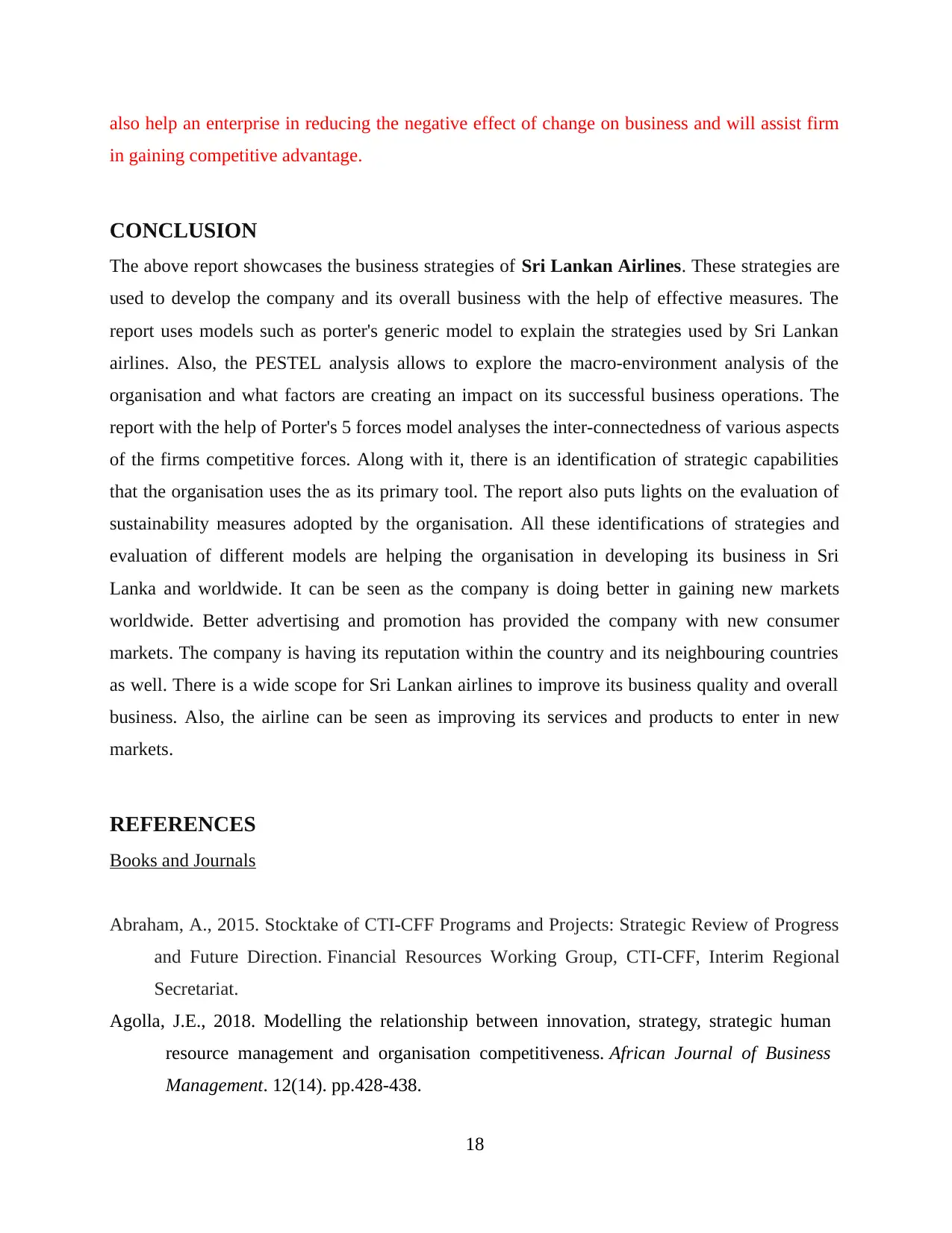
also help an enterprise in reducing the negative effect of change on business and will assist firm
in gaining competitive advantage.
CONCLUSION
The above report showcases the business strategies of Sri Lankan Airlines. These strategies are
used to develop the company and its overall business with the help of effective measures. The
report uses models such as porter's generic model to explain the strategies used by Sri Lankan
airlines. Also, the PESTEL analysis allows to explore the macro-environment analysis of the
organisation and what factors are creating an impact on its successful business operations. The
report with the help of Porter's 5 forces model analyses the inter-connectedness of various aspects
of the firms competitive forces. Along with it, there is an identification of strategic capabilities
that the organisation uses the as its primary tool. The report also puts lights on the evaluation of
sustainability measures adopted by the organisation. All these identifications of strategies and
evaluation of different models are helping the organisation in developing its business in Sri
Lanka and worldwide. It can be seen as the company is doing better in gaining new markets
worldwide. Better advertising and promotion has provided the company with new consumer
markets. The company is having its reputation within the country and its neighbouring countries
as well. There is a wide scope for Sri Lankan airlines to improve its business quality and overall
business. Also, the airline can be seen as improving its services and products to enter in new
markets.
REFERENCES
Books and Journals
Abraham, A., 2015. Stocktake of CTI-CFF Programs and Projects: Strategic Review of Progress
and Future Direction. Financial Resources Working Group, CTI-CFF, Interim Regional
Secretariat.
Agolla, J.E., 2018. Modelling the relationship between innovation, strategy, strategic human
resource management and organisation competitiveness. African Journal of Business
Management. 12(14). pp.428-438.
18
in gaining competitive advantage.
CONCLUSION
The above report showcases the business strategies of Sri Lankan Airlines. These strategies are
used to develop the company and its overall business with the help of effective measures. The
report uses models such as porter's generic model to explain the strategies used by Sri Lankan
airlines. Also, the PESTEL analysis allows to explore the macro-environment analysis of the
organisation and what factors are creating an impact on its successful business operations. The
report with the help of Porter's 5 forces model analyses the inter-connectedness of various aspects
of the firms competitive forces. Along with it, there is an identification of strategic capabilities
that the organisation uses the as its primary tool. The report also puts lights on the evaluation of
sustainability measures adopted by the organisation. All these identifications of strategies and
evaluation of different models are helping the organisation in developing its business in Sri
Lanka and worldwide. It can be seen as the company is doing better in gaining new markets
worldwide. Better advertising and promotion has provided the company with new consumer
markets. The company is having its reputation within the country and its neighbouring countries
as well. There is a wide scope for Sri Lankan airlines to improve its business quality and overall
business. Also, the airline can be seen as improving its services and products to enter in new
markets.
REFERENCES
Books and Journals
Abraham, A., 2015. Stocktake of CTI-CFF Programs and Projects: Strategic Review of Progress
and Future Direction. Financial Resources Working Group, CTI-CFF, Interim Regional
Secretariat.
Agolla, J.E., 2018. Modelling the relationship between innovation, strategy, strategic human
resource management and organisation competitiveness. African Journal of Business
Management. 12(14). pp.428-438.
18
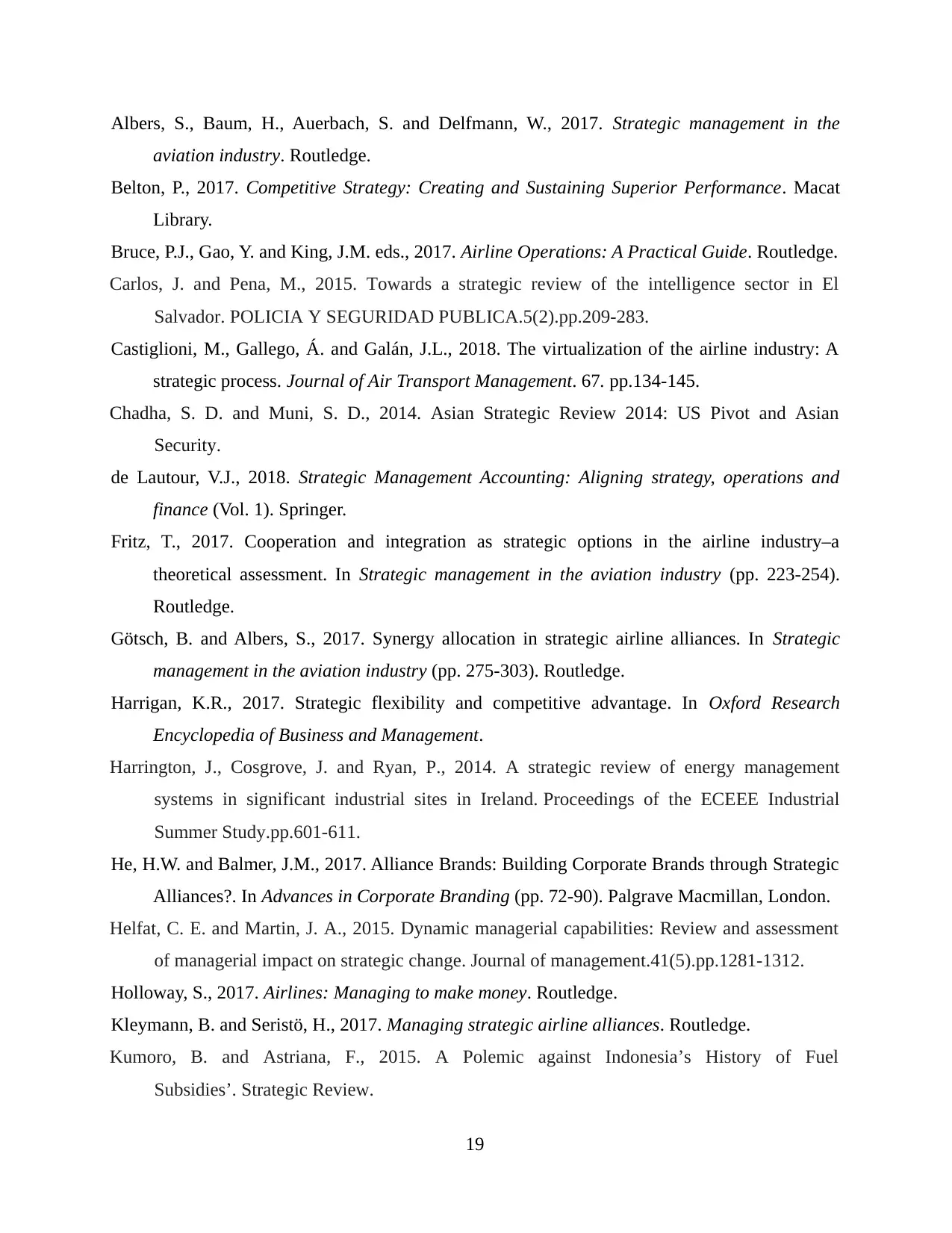
Albers, S., Baum, H., Auerbach, S. and Delfmann, W., 2017. Strategic management in the
aviation industry. Routledge.
Belton, P., 2017. Competitive Strategy: Creating and Sustaining Superior Performance. Macat
Library.
Bruce, P.J., Gao, Y. and King, J.M. eds., 2017. Airline Operations: A Practical Guide. Routledge.
Carlos, J. and Pena, M., 2015. Towards a strategic review of the intelligence sector in El
Salvador. POLICIA Y SEGURIDAD PUBLICA.5(2).pp.209-283.
Castiglioni, M., Gallego, Á. and Galán, J.L., 2018. The virtualization of the airline industry: A
strategic process. Journal of Air Transport Management. 67. pp.134-145.
Chadha, S. D. and Muni, S. D., 2014. Asian Strategic Review 2014: US Pivot and Asian
Security.
de Lautour, V.J., 2018. Strategic Management Accounting: Aligning strategy, operations and
finance (Vol. 1). Springer.
Fritz, T., 2017. Cooperation and integration as strategic options in the airline industry–a
theoretical assessment. In Strategic management in the aviation industry (pp. 223-254).
Routledge.
Götsch, B. and Albers, S., 2017. Synergy allocation in strategic airline alliances. In Strategic
management in the aviation industry (pp. 275-303). Routledge.
Harrigan, K.R., 2017. Strategic flexibility and competitive advantage. In Oxford Research
Encyclopedia of Business and Management.
Harrington, J., Cosgrove, J. and Ryan, P., 2014. A strategic review of energy management
systems in significant industrial sites in Ireland. Proceedings of the ECEEE Industrial
Summer Study.pp.601-611.
He, H.W. and Balmer, J.M., 2017. Alliance Brands: Building Corporate Brands through Strategic
Alliances?. In Advances in Corporate Branding (pp. 72-90). Palgrave Macmillan, London.
Helfat, C. E. and Martin, J. A., 2015. Dynamic managerial capabilities: Review and assessment
of managerial impact on strategic change. Journal of management.41(5).pp.1281-1312.
Holloway, S., 2017. Airlines: Managing to make money. Routledge.
Kleymann, B. and Seristö, H., 2017. Managing strategic airline alliances. Routledge.
Kumoro, B. and Astriana, F., 2015. A Polemic against Indonesia’s History of Fuel
Subsidies’. Strategic Review.
19
aviation industry. Routledge.
Belton, P., 2017. Competitive Strategy: Creating and Sustaining Superior Performance. Macat
Library.
Bruce, P.J., Gao, Y. and King, J.M. eds., 2017. Airline Operations: A Practical Guide. Routledge.
Carlos, J. and Pena, M., 2015. Towards a strategic review of the intelligence sector in El
Salvador. POLICIA Y SEGURIDAD PUBLICA.5(2).pp.209-283.
Castiglioni, M., Gallego, Á. and Galán, J.L., 2018. The virtualization of the airline industry: A
strategic process. Journal of Air Transport Management. 67. pp.134-145.
Chadha, S. D. and Muni, S. D., 2014. Asian Strategic Review 2014: US Pivot and Asian
Security.
de Lautour, V.J., 2018. Strategic Management Accounting: Aligning strategy, operations and
finance (Vol. 1). Springer.
Fritz, T., 2017. Cooperation and integration as strategic options in the airline industry–a
theoretical assessment. In Strategic management in the aviation industry (pp. 223-254).
Routledge.
Götsch, B. and Albers, S., 2017. Synergy allocation in strategic airline alliances. In Strategic
management in the aviation industry (pp. 275-303). Routledge.
Harrigan, K.R., 2017. Strategic flexibility and competitive advantage. In Oxford Research
Encyclopedia of Business and Management.
Harrington, J., Cosgrove, J. and Ryan, P., 2014. A strategic review of energy management
systems in significant industrial sites in Ireland. Proceedings of the ECEEE Industrial
Summer Study.pp.601-611.
He, H.W. and Balmer, J.M., 2017. Alliance Brands: Building Corporate Brands through Strategic
Alliances?. In Advances in Corporate Branding (pp. 72-90). Palgrave Macmillan, London.
Helfat, C. E. and Martin, J. A., 2015. Dynamic managerial capabilities: Review and assessment
of managerial impact on strategic change. Journal of management.41(5).pp.1281-1312.
Holloway, S., 2017. Airlines: Managing to make money. Routledge.
Kleymann, B. and Seristö, H., 2017. Managing strategic airline alliances. Routledge.
Kumoro, B. and Astriana, F., 2015. A Polemic against Indonesia’s History of Fuel
Subsidies’. Strategic Review.
19
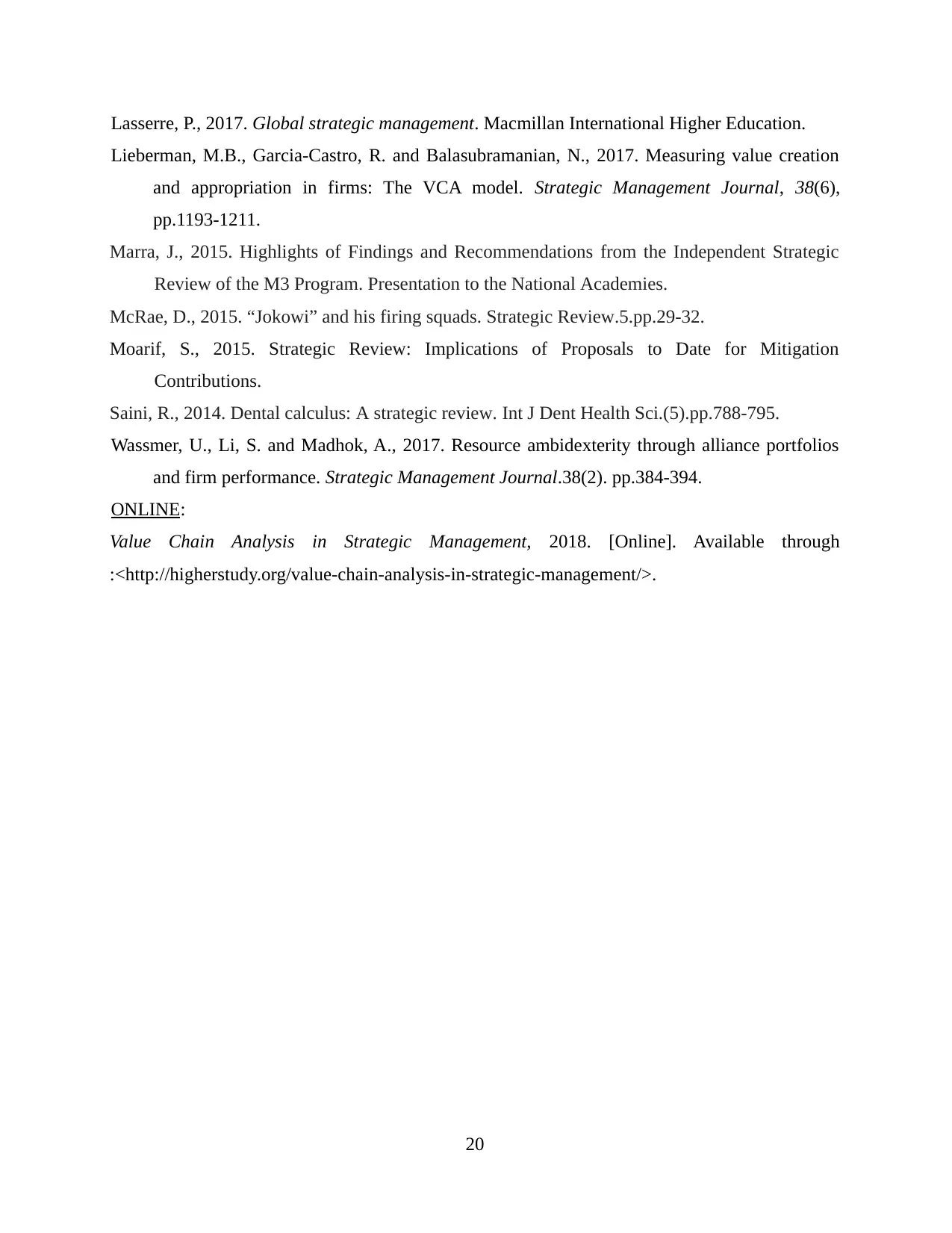
Lasserre, P., 2017. Global strategic management. Macmillan International Higher Education.
Lieberman, M.B., Garcia‐Castro, R. and Balasubramanian, N., 2017. Measuring value creation
and appropriation in firms: The VCA model. Strategic Management Journal, 38(6),
pp.1193-1211.
Marra, J., 2015. Highlights of Findings and Recommendations from the Independent Strategic
Review of the M3 Program. Presentation to the National Academies.
McRae, D., 2015. “Jokowi” and his firing squads. Strategic Review.5.pp.29-32.
Moarif, S., 2015. Strategic Review: Implications of Proposals to Date for Mitigation
Contributions.
Saini, R., 2014. Dental calculus: A strategic review. Int J Dent Health Sci.(5).pp.788-795.
Wassmer, U., Li, S. and Madhok, A., 2017. Resource ambidexterity through alliance portfolios
and firm performance. Strategic Management Journal.38(2). pp.384-394.
ONLINE:
Value Chain Analysis in Strategic Management, 2018. [Online]. Available through
:<http://higherstudy.org/value-chain-analysis-in-strategic-management/>.
20
Lieberman, M.B., Garcia‐Castro, R. and Balasubramanian, N., 2017. Measuring value creation
and appropriation in firms: The VCA model. Strategic Management Journal, 38(6),
pp.1193-1211.
Marra, J., 2015. Highlights of Findings and Recommendations from the Independent Strategic
Review of the M3 Program. Presentation to the National Academies.
McRae, D., 2015. “Jokowi” and his firing squads. Strategic Review.5.pp.29-32.
Moarif, S., 2015. Strategic Review: Implications of Proposals to Date for Mitigation
Contributions.
Saini, R., 2014. Dental calculus: A strategic review. Int J Dent Health Sci.(5).pp.788-795.
Wassmer, U., Li, S. and Madhok, A., 2017. Resource ambidexterity through alliance portfolios
and firm performance. Strategic Management Journal.38(2). pp.384-394.
ONLINE:
Value Chain Analysis in Strategic Management, 2018. [Online]. Available through
:<http://higherstudy.org/value-chain-analysis-in-strategic-management/>.
20
1 out of 22
Related Documents
Your All-in-One AI-Powered Toolkit for Academic Success.
+13062052269
info@desklib.com
Available 24*7 on WhatsApp / Email
![[object Object]](/_next/static/media/star-bottom.7253800d.svg)
Unlock your academic potential
© 2024 | Zucol Services PVT LTD | All rights reserved.





